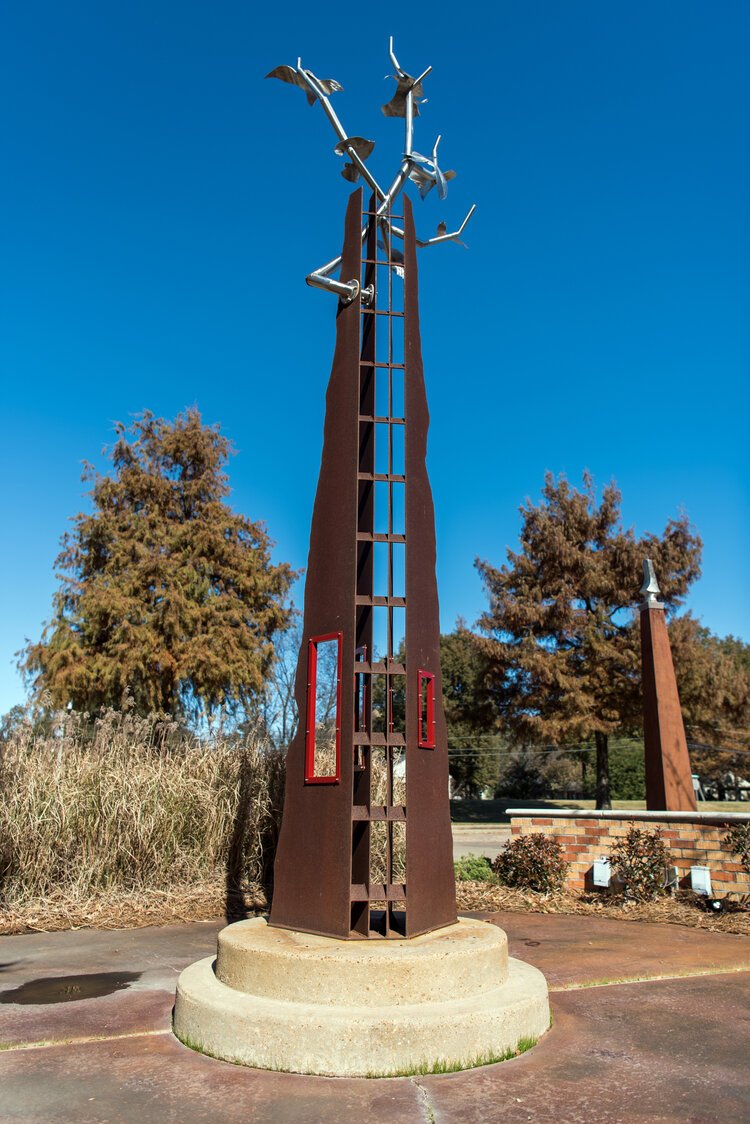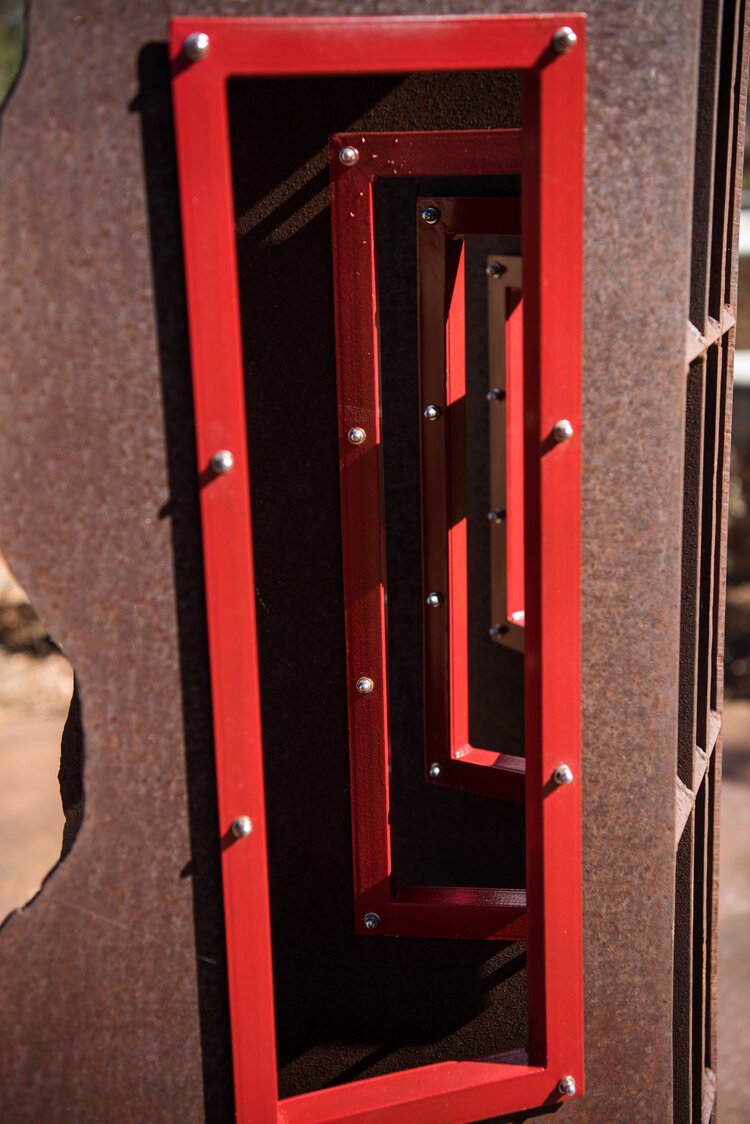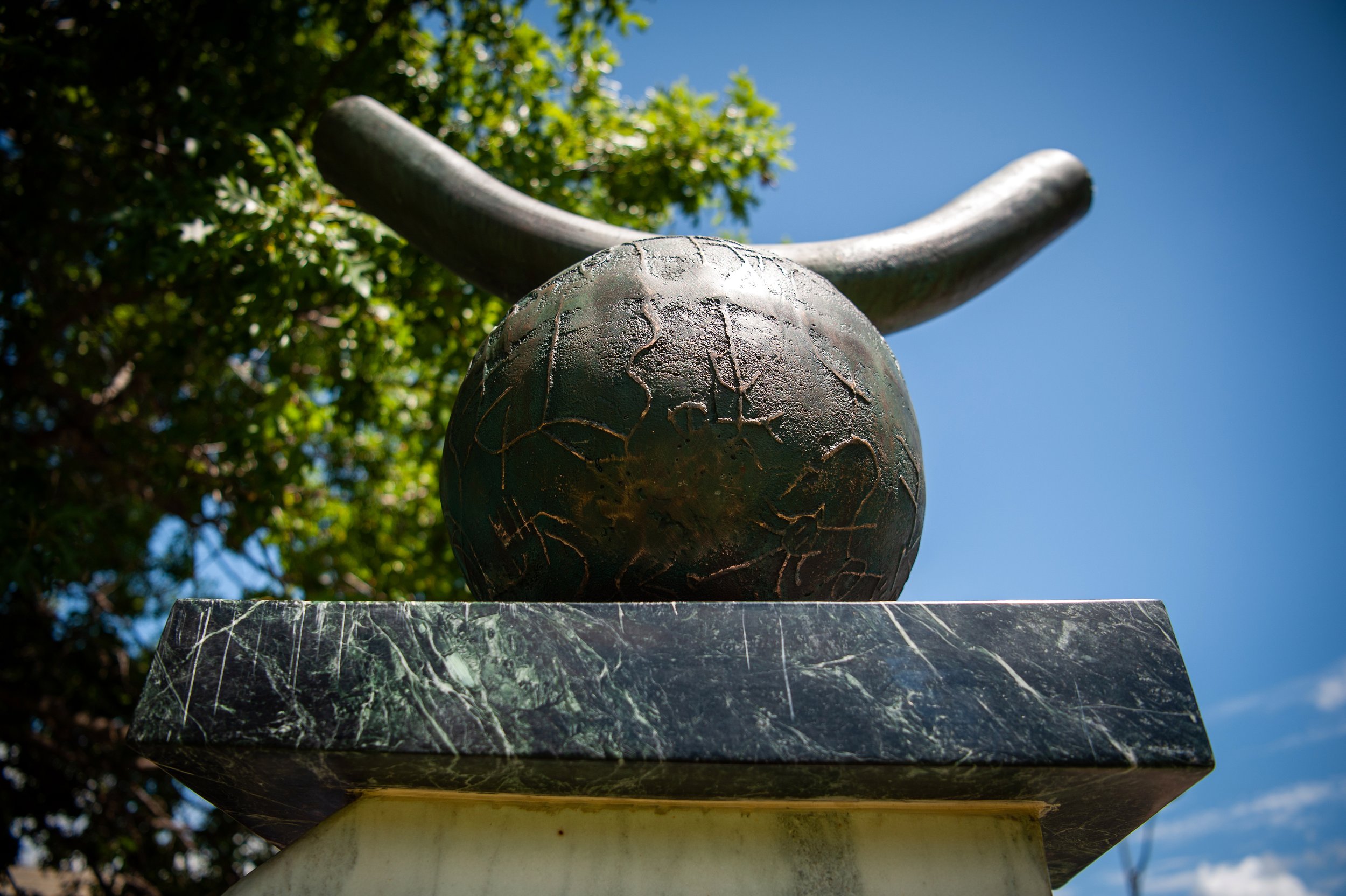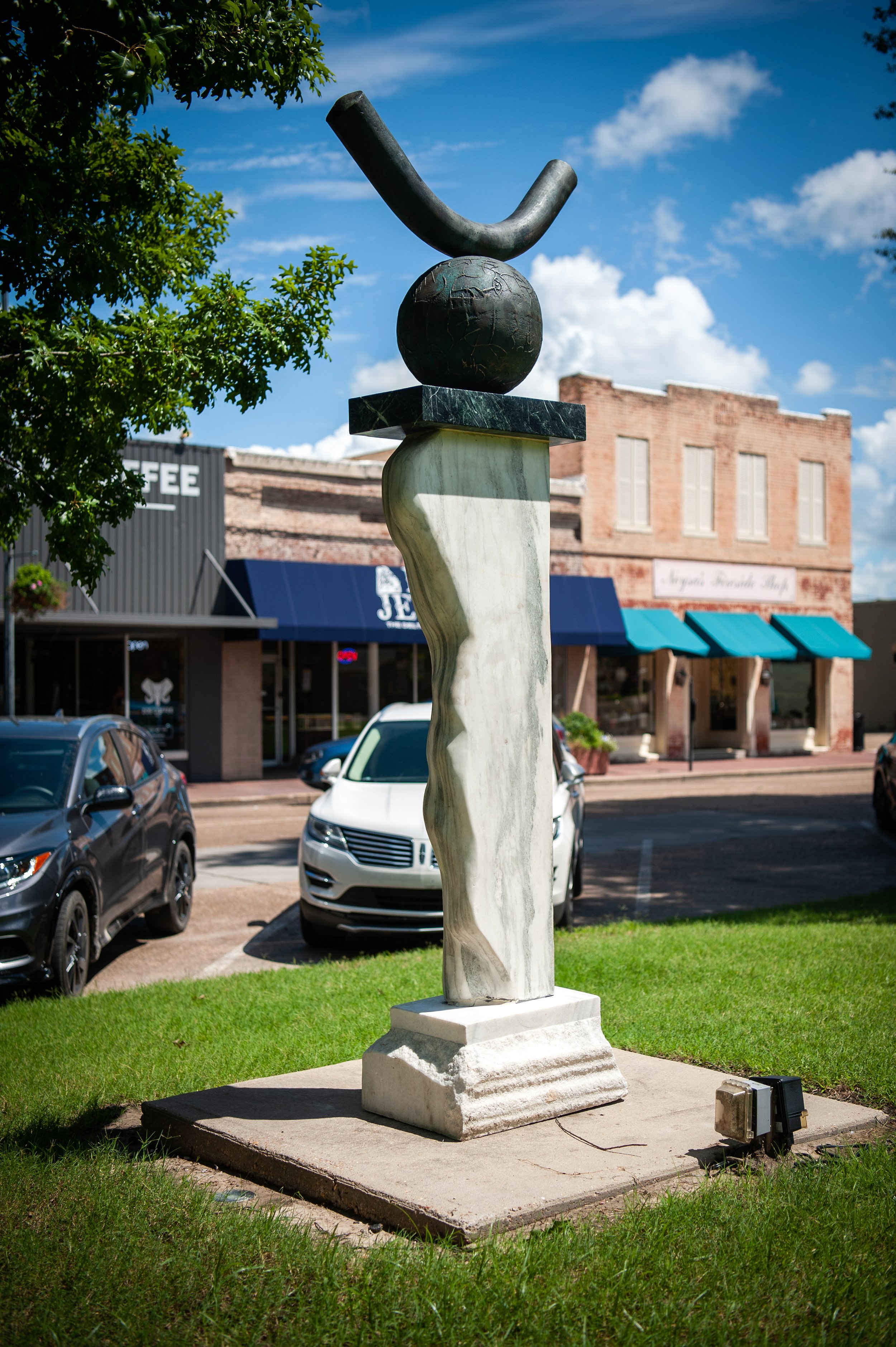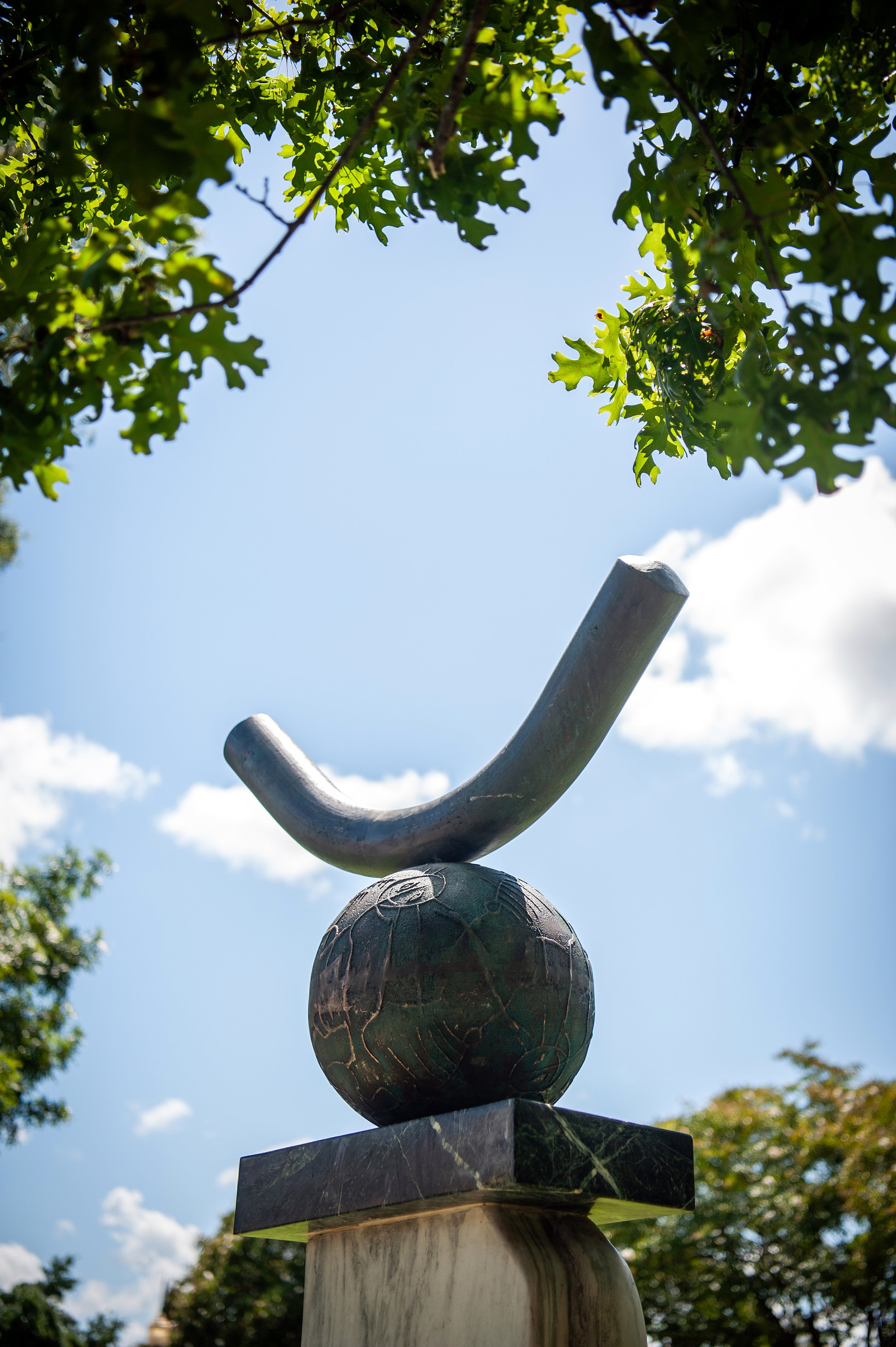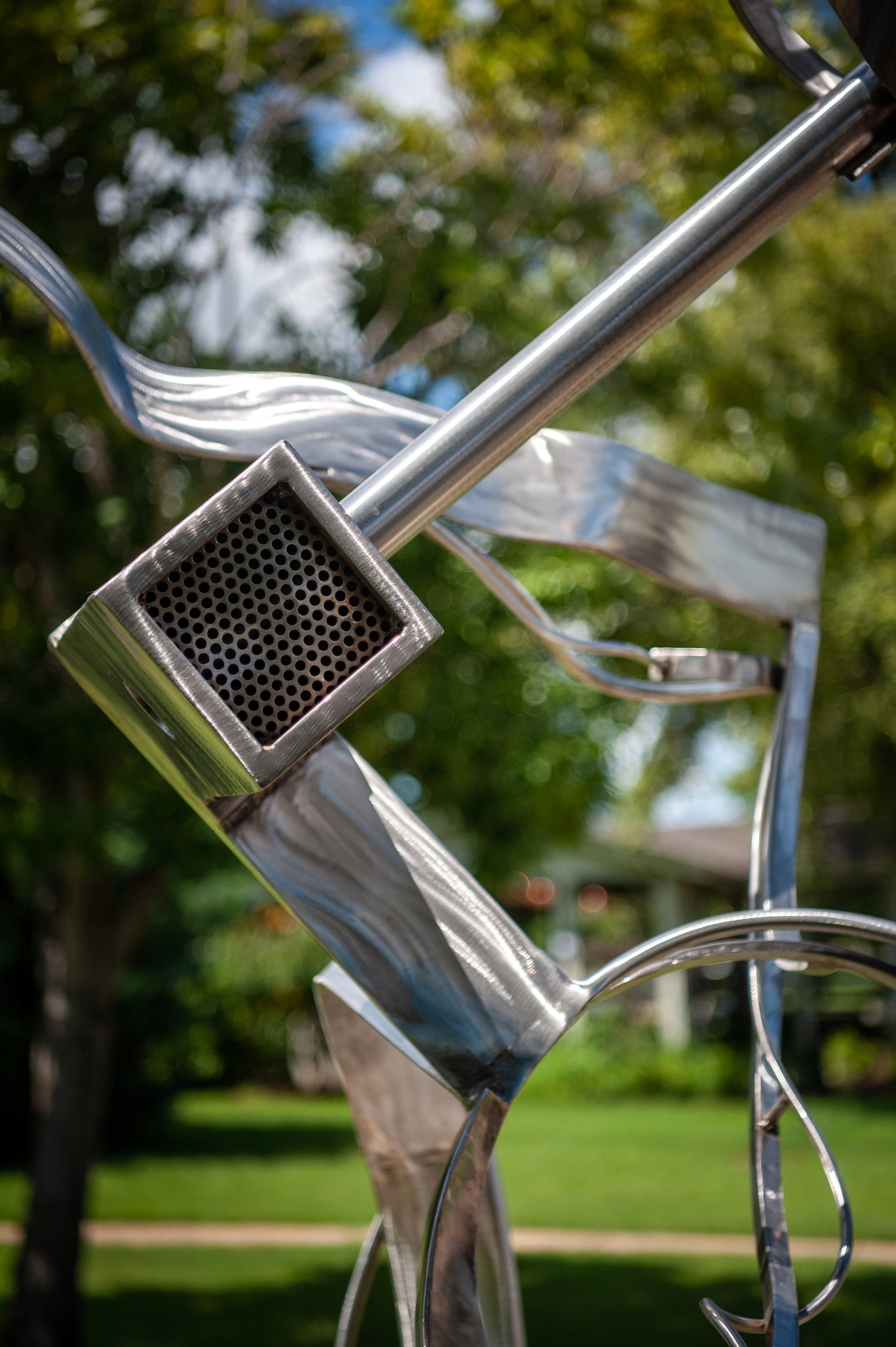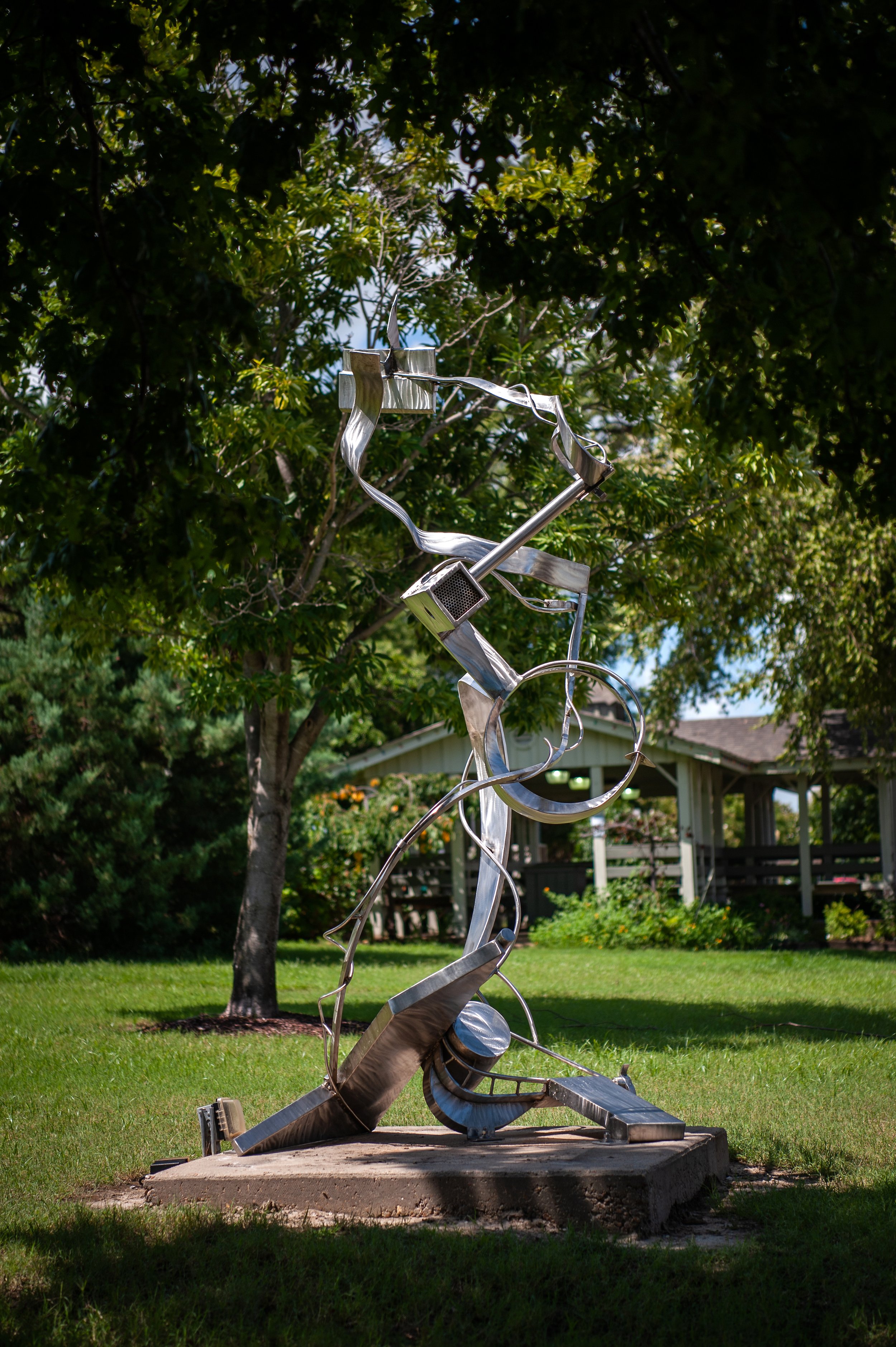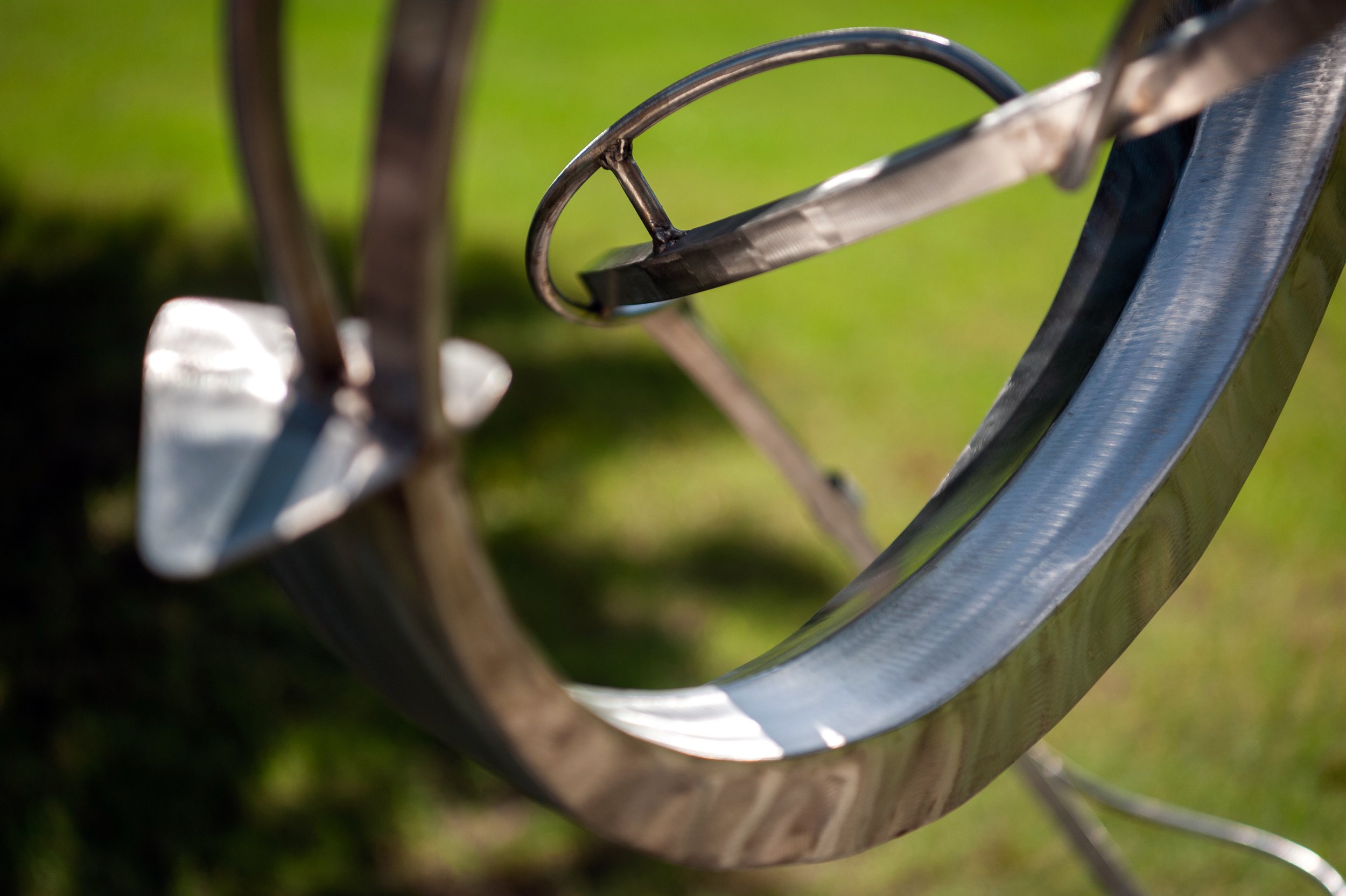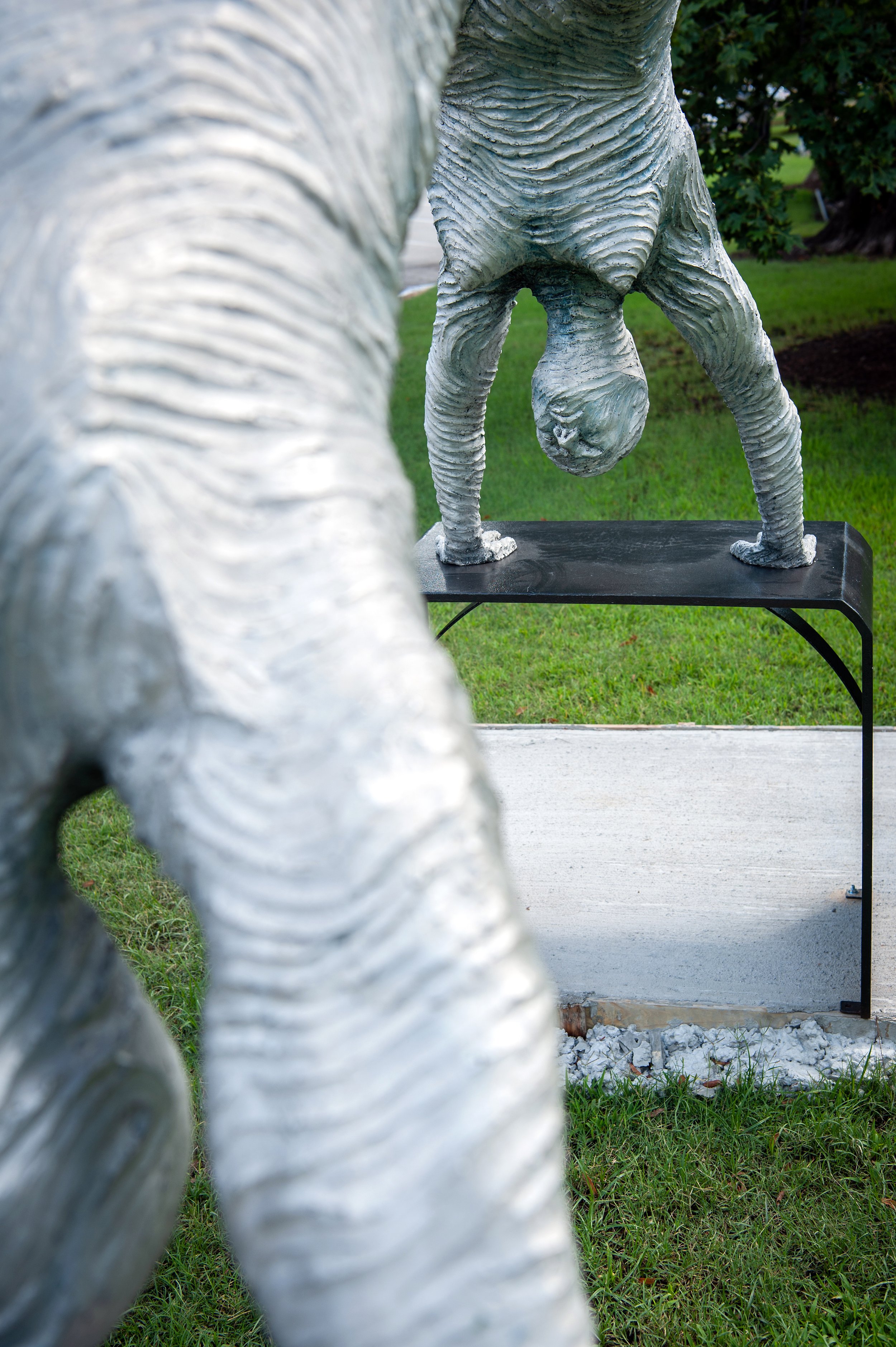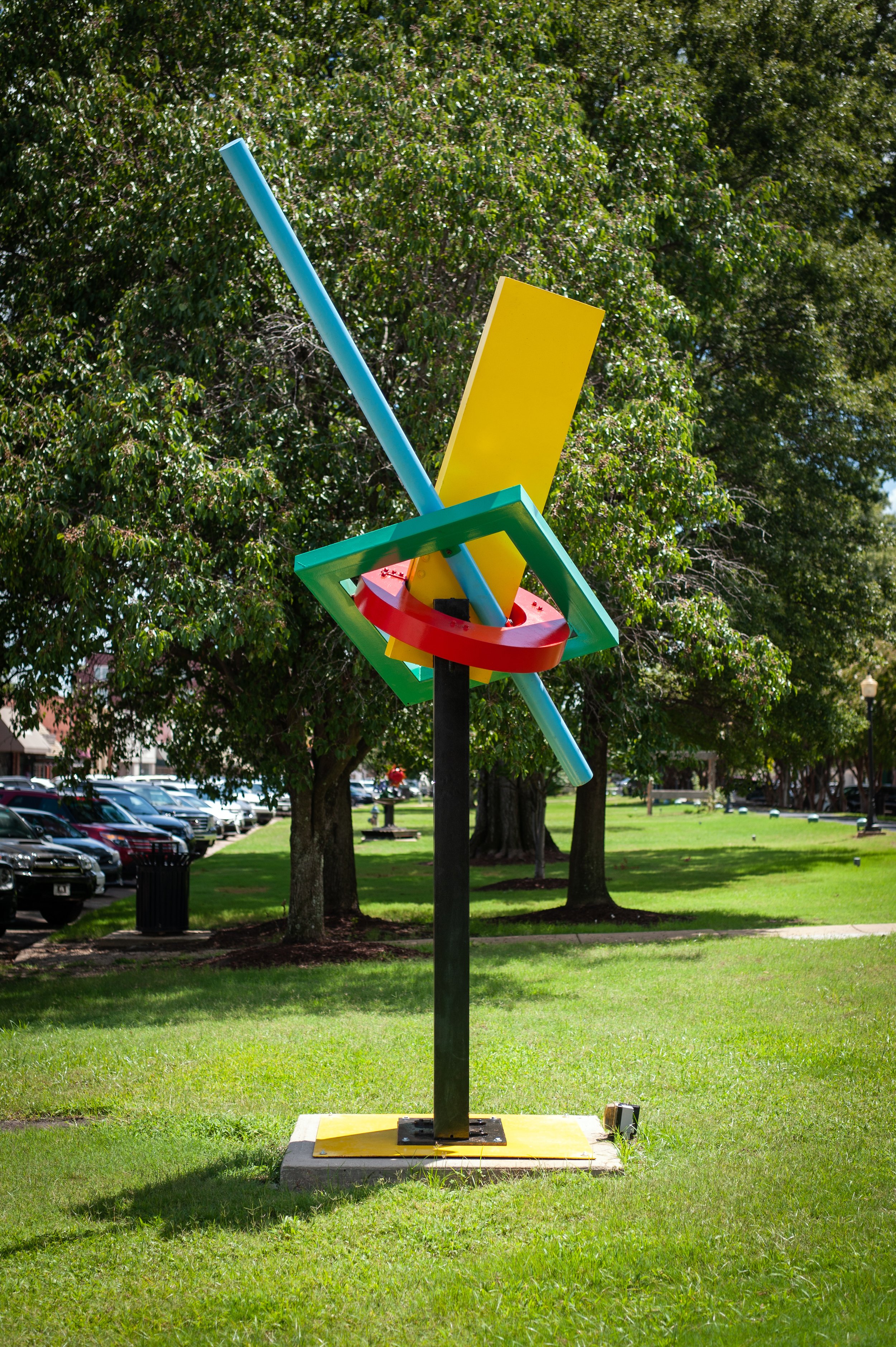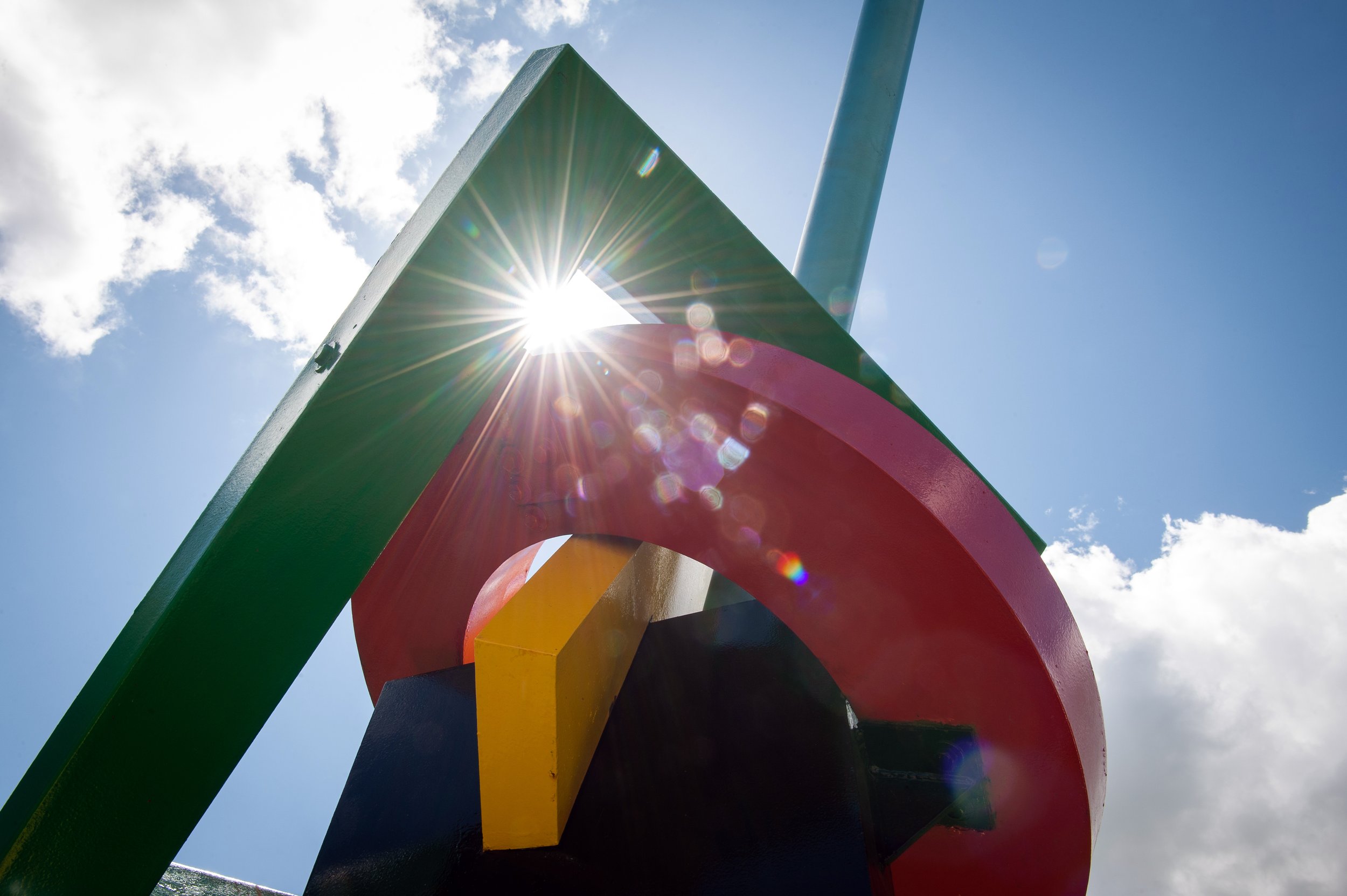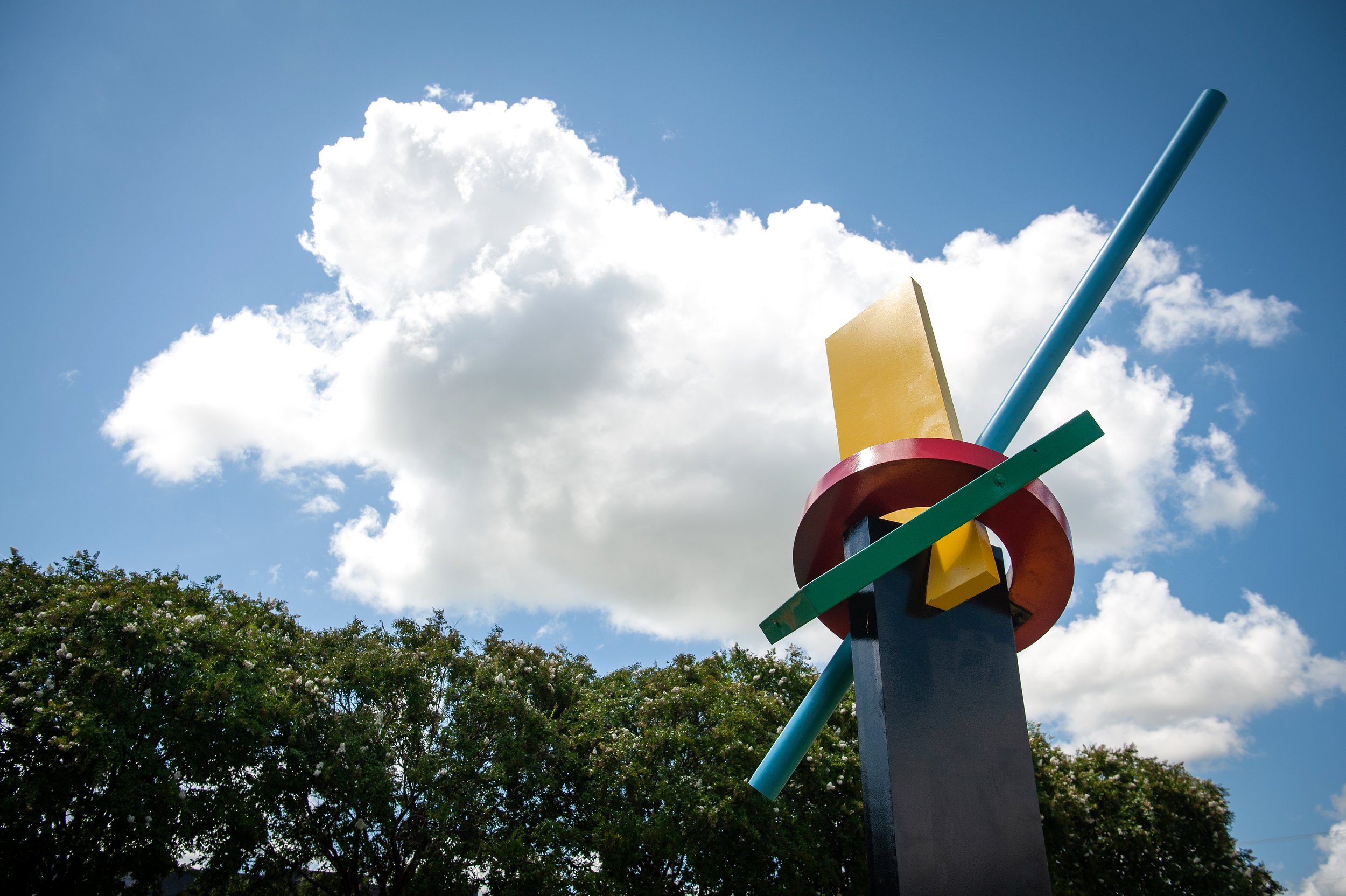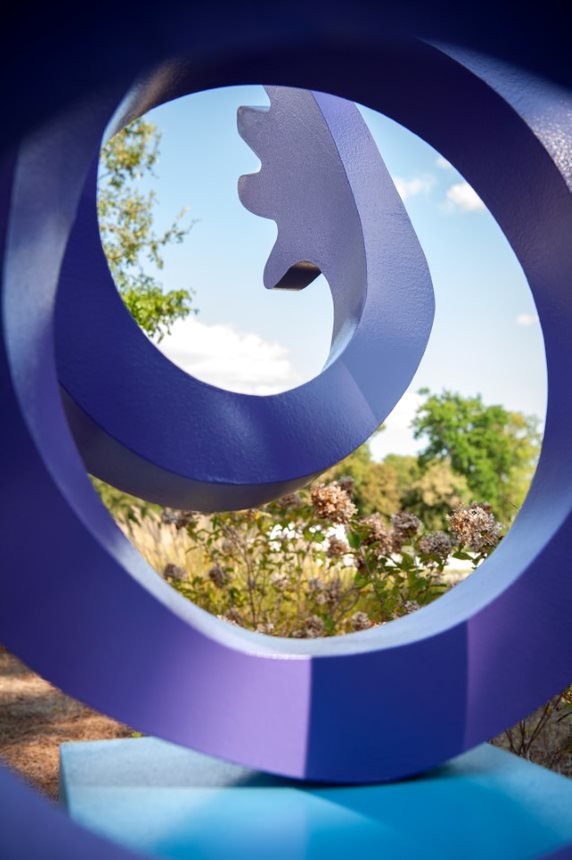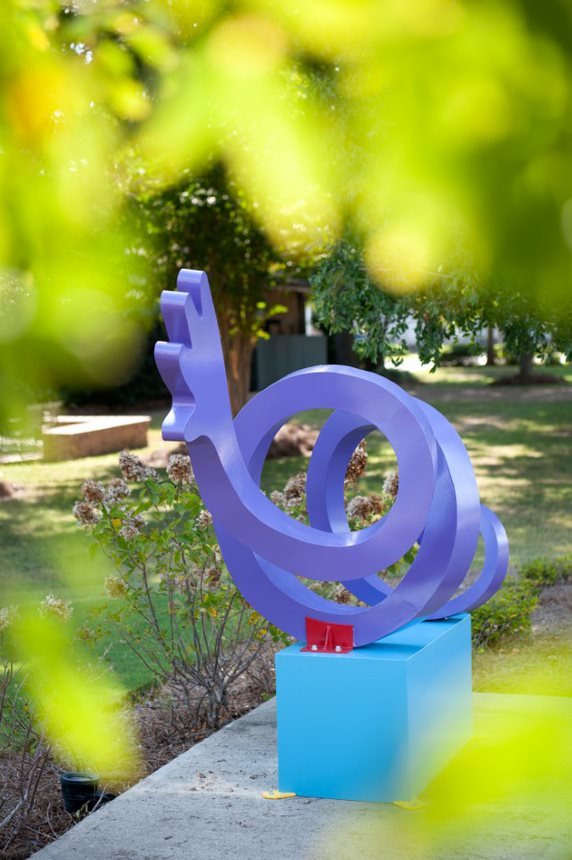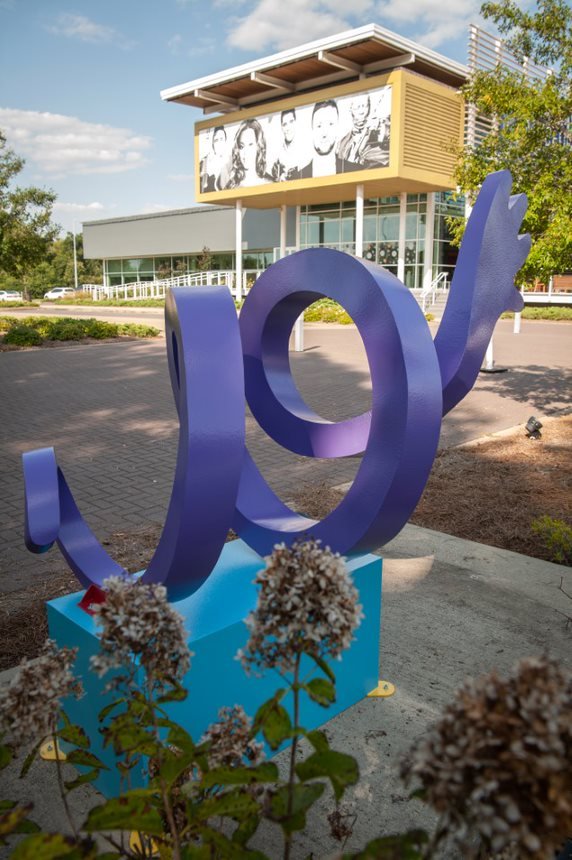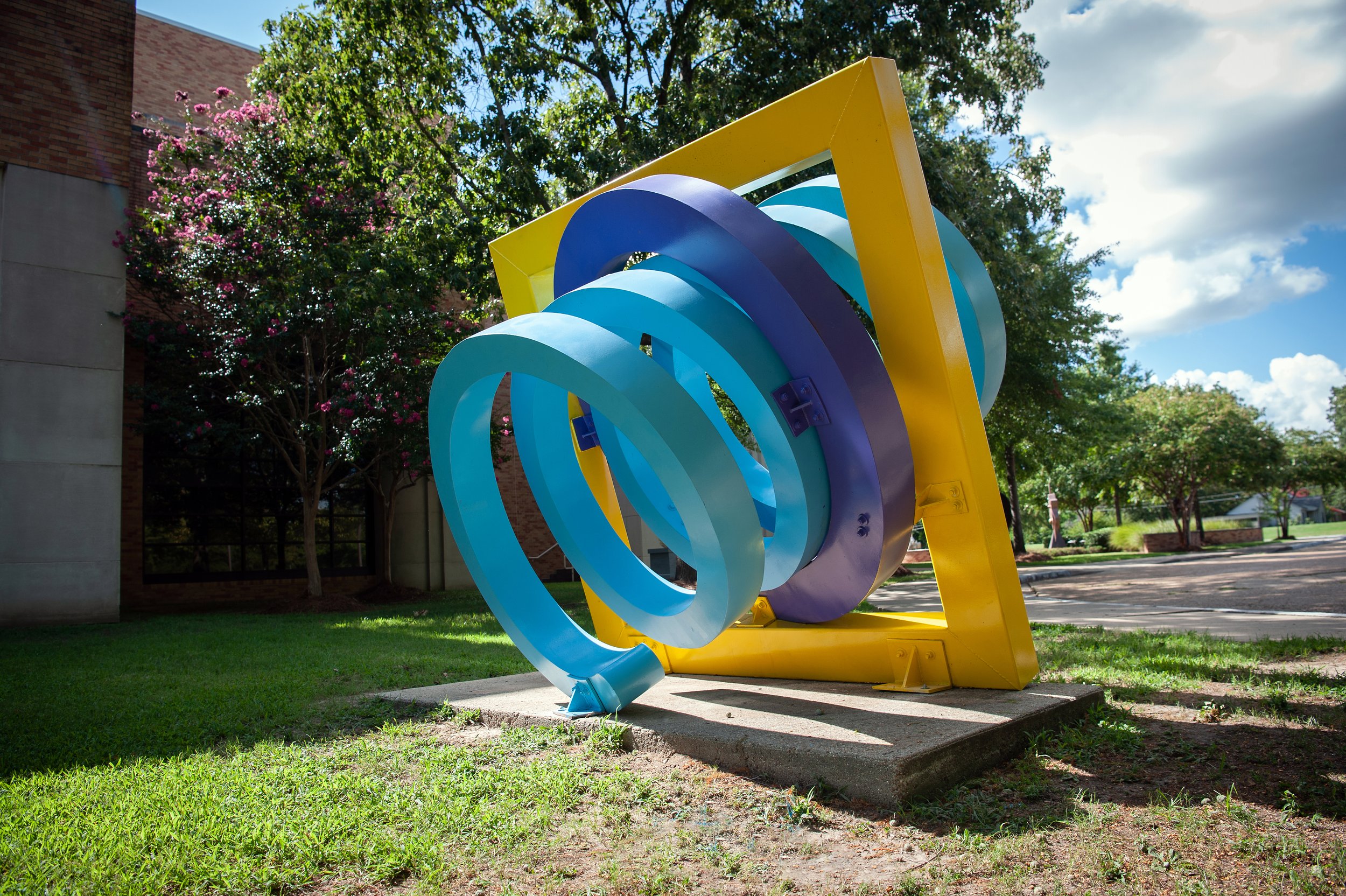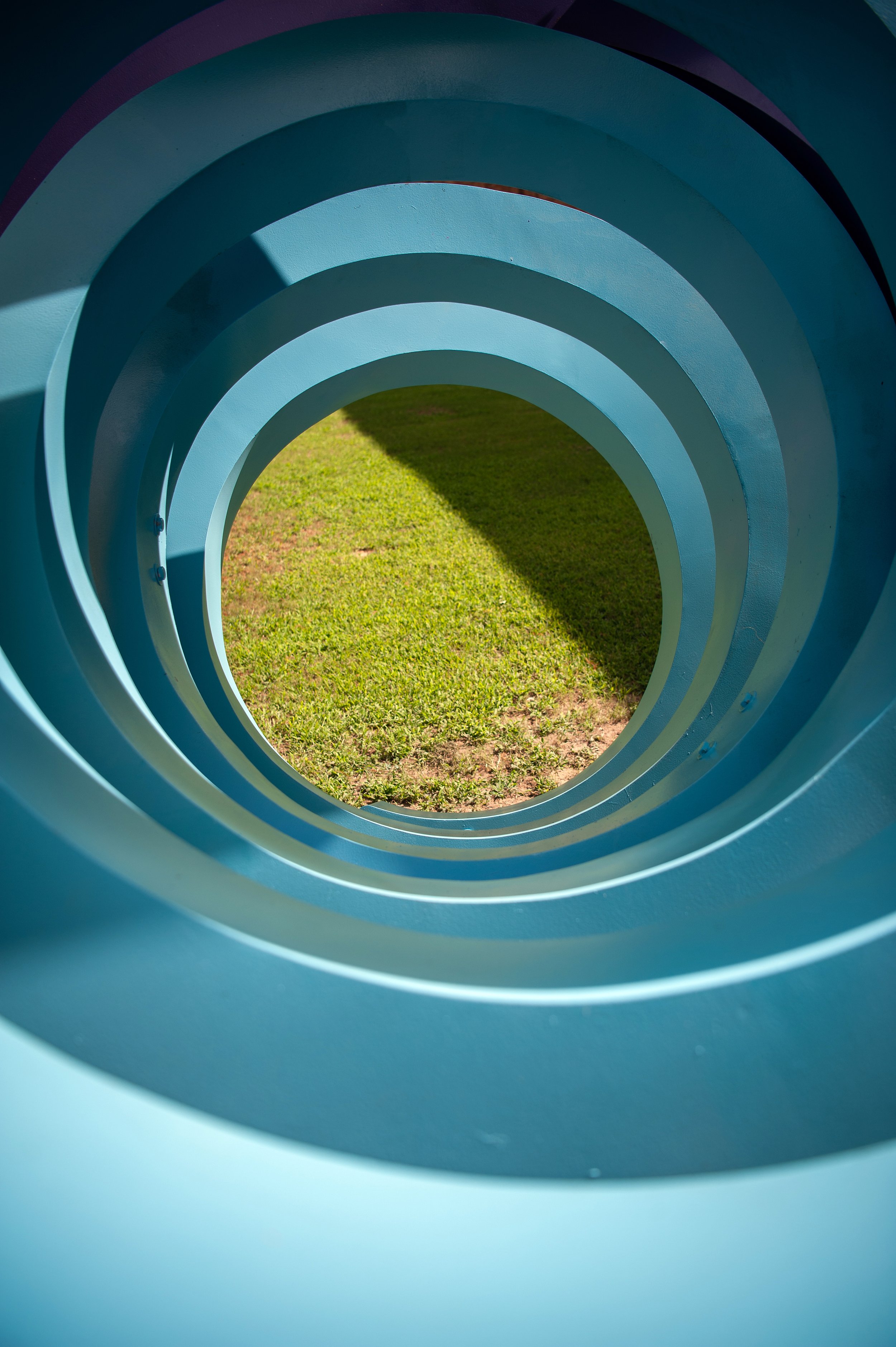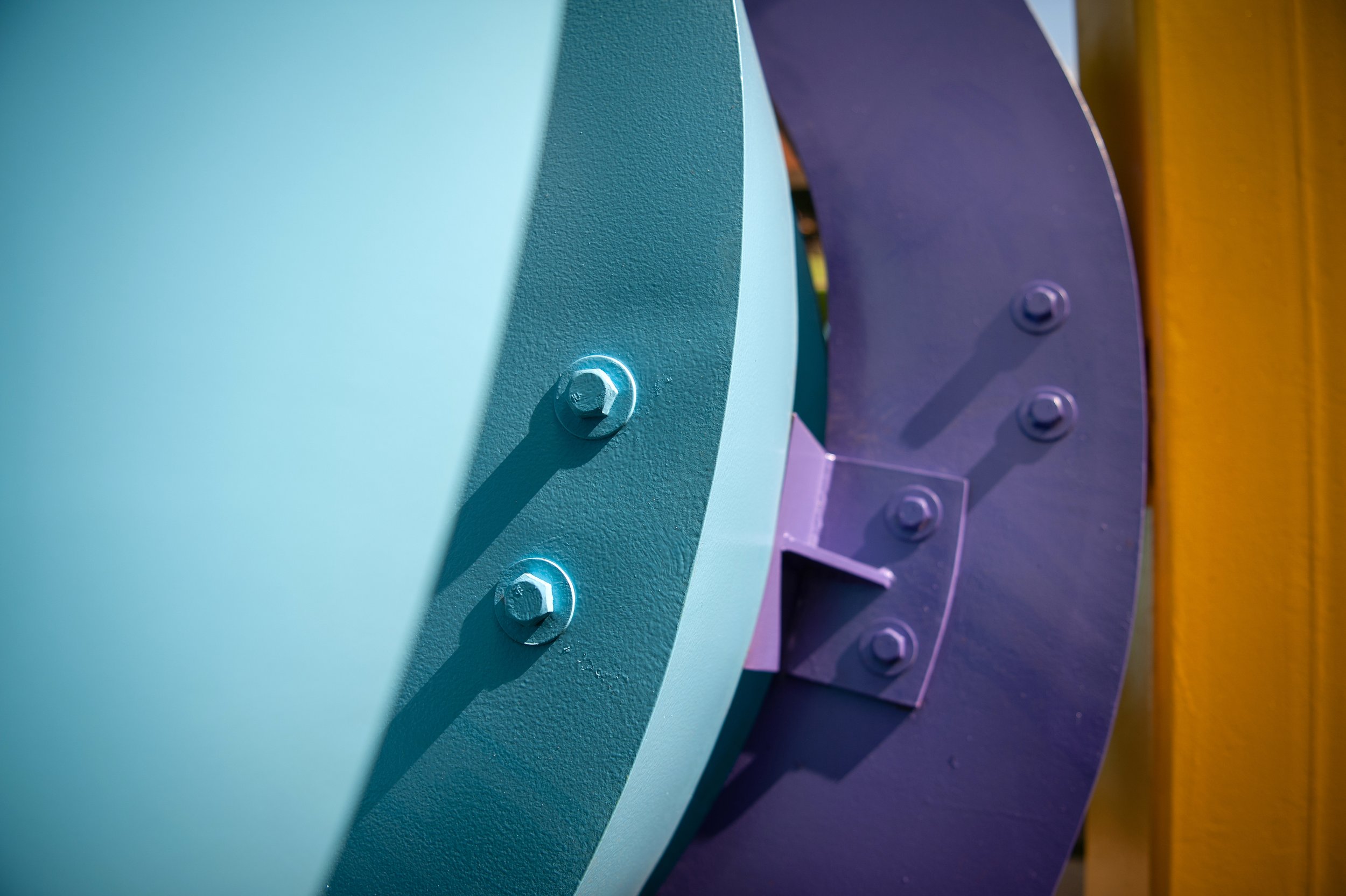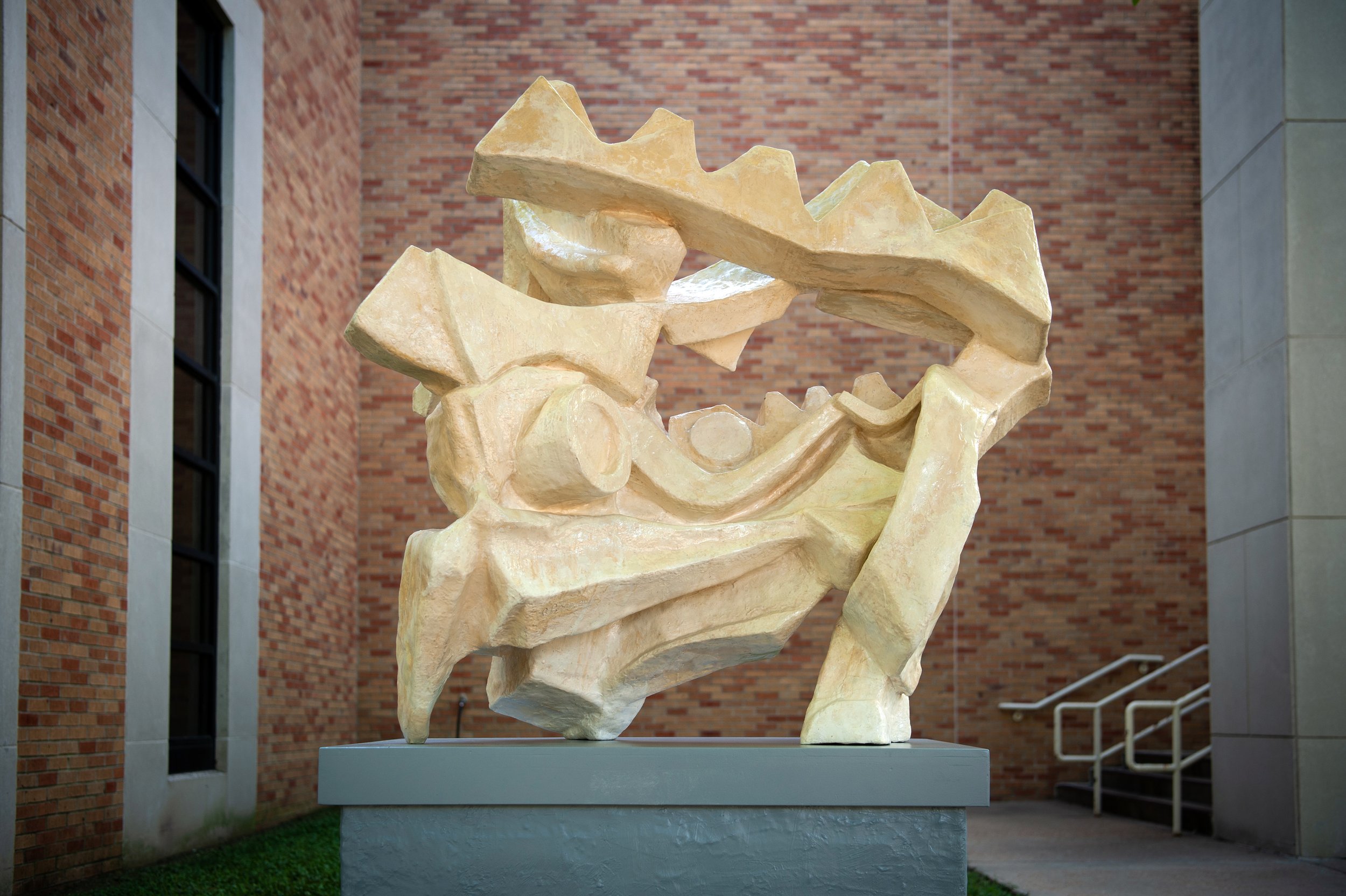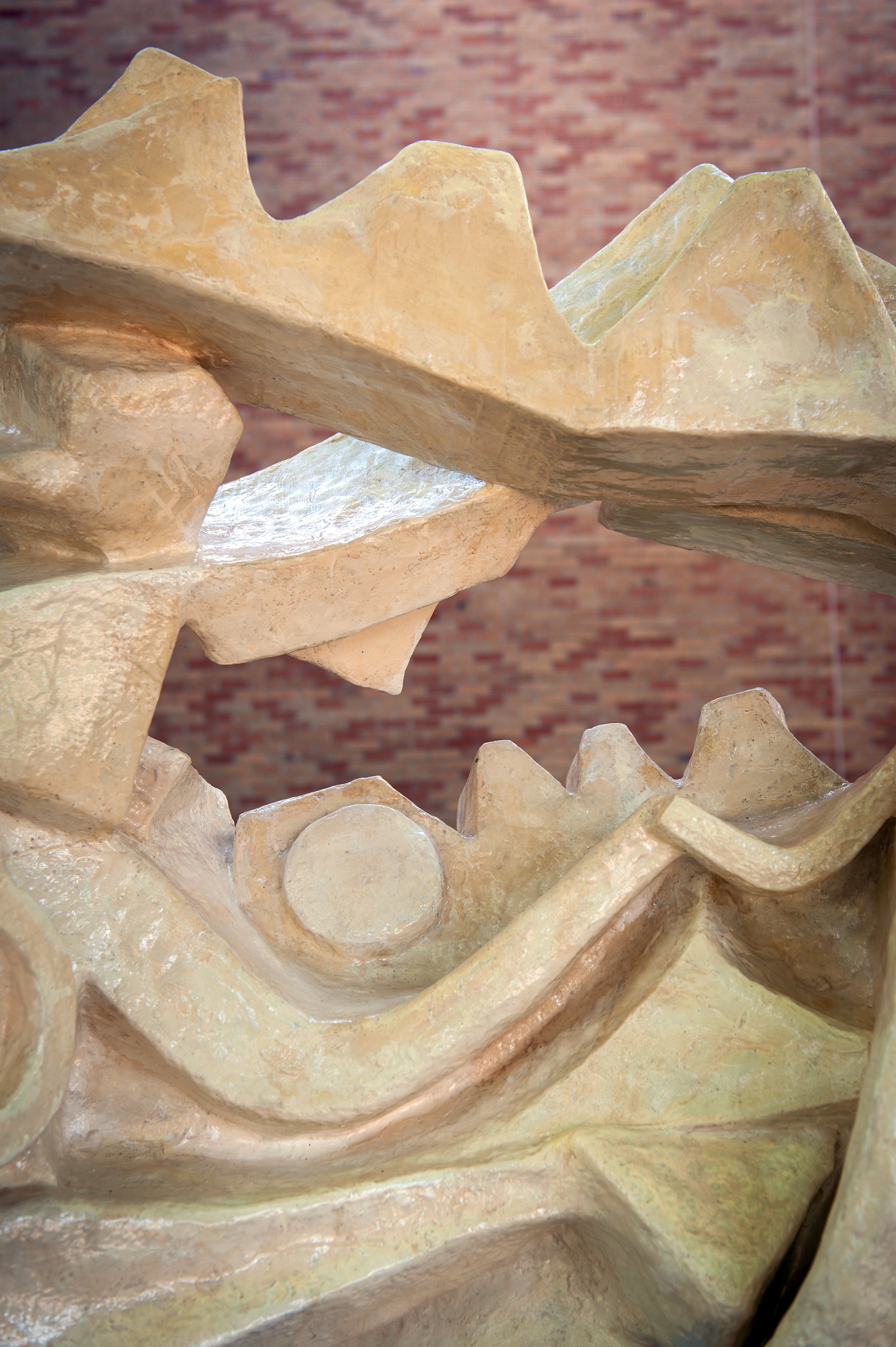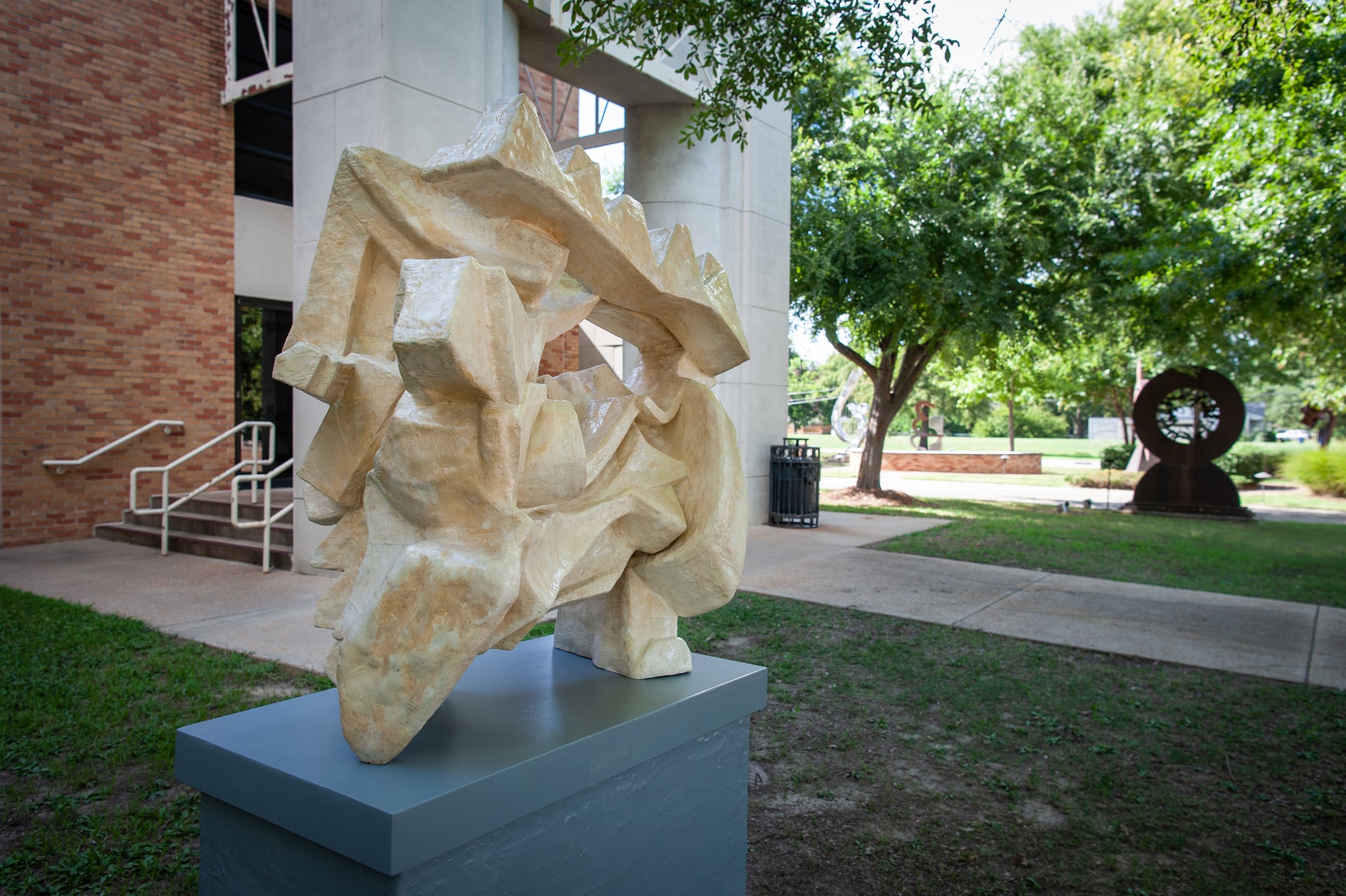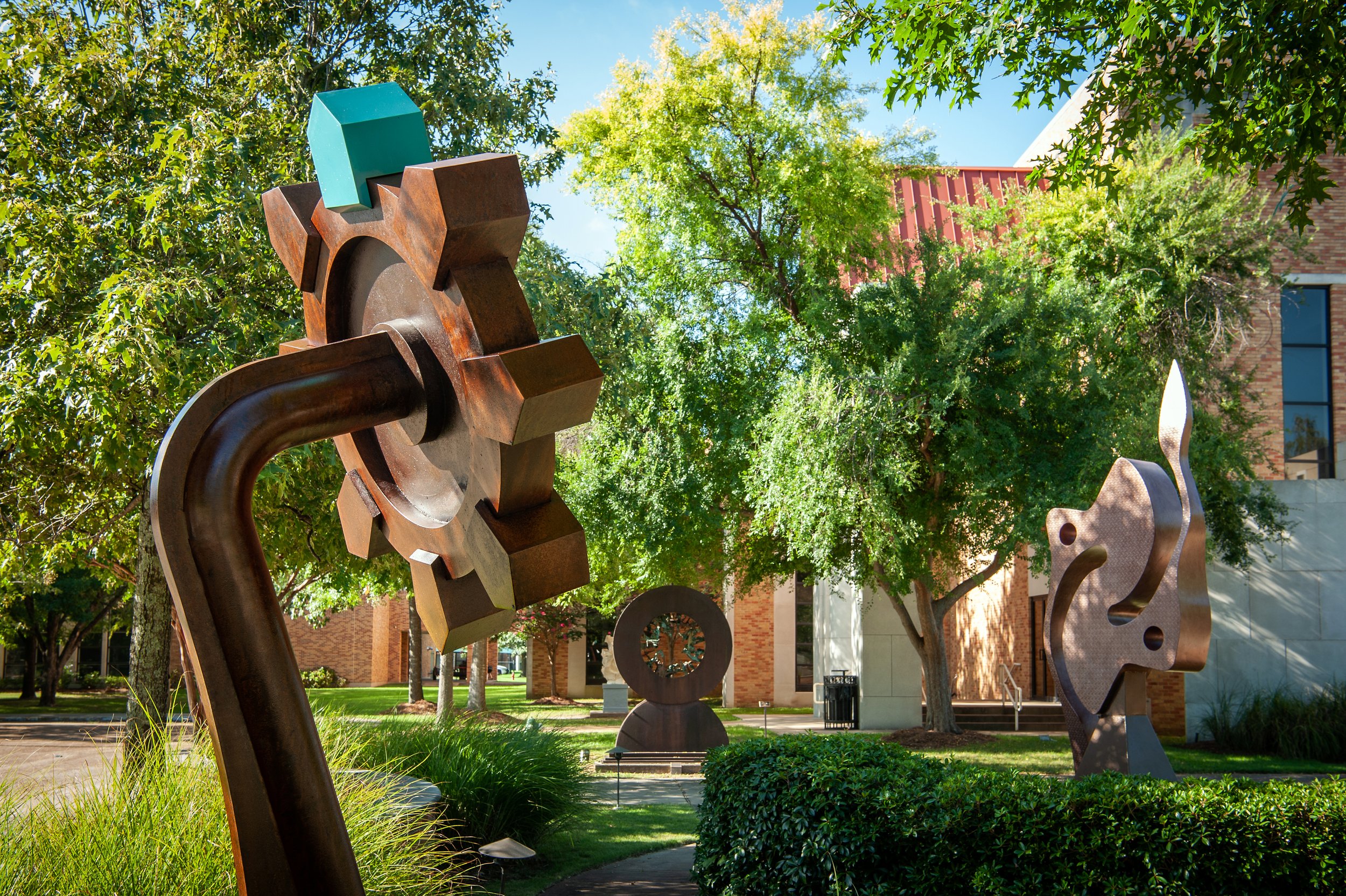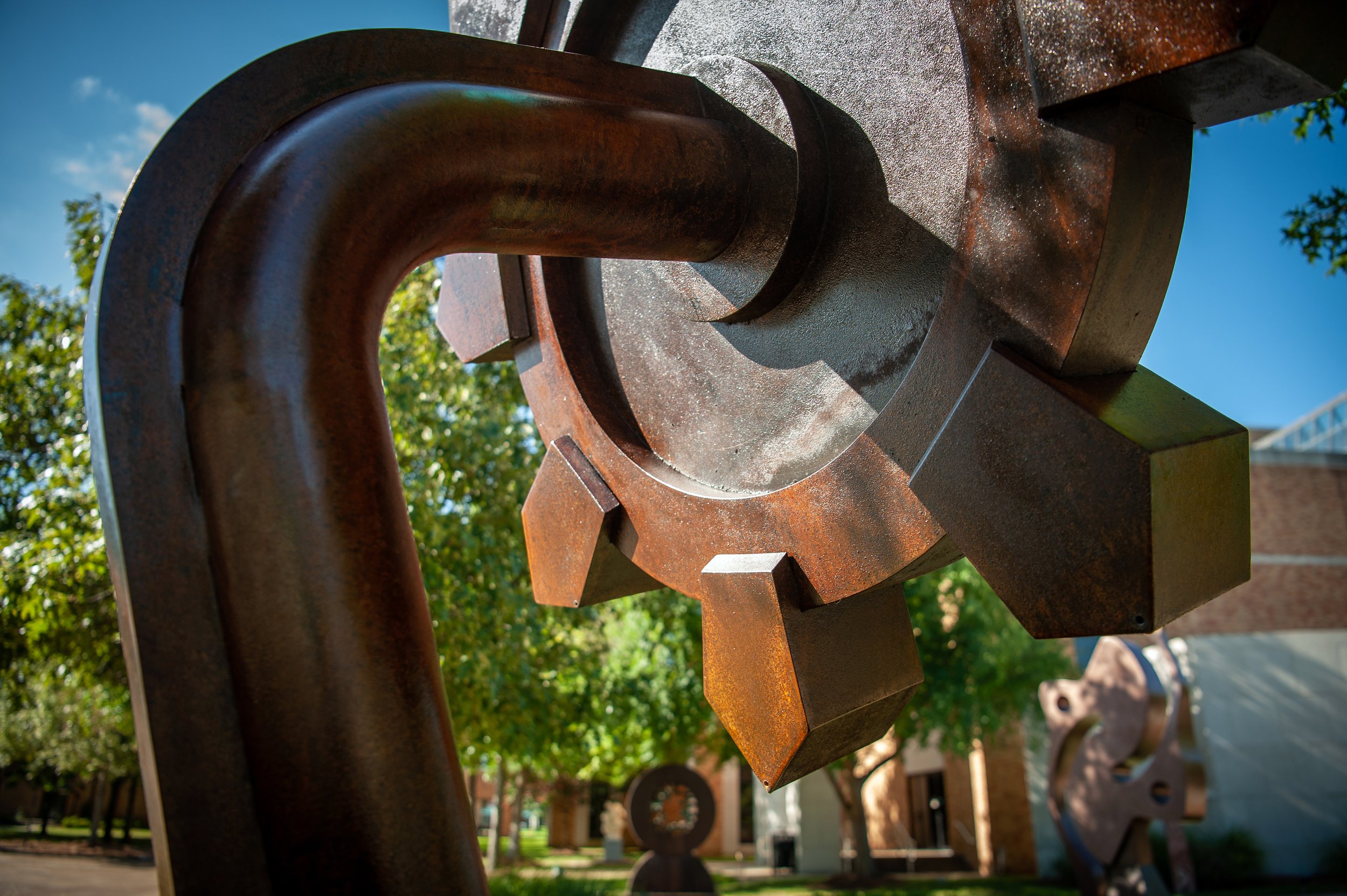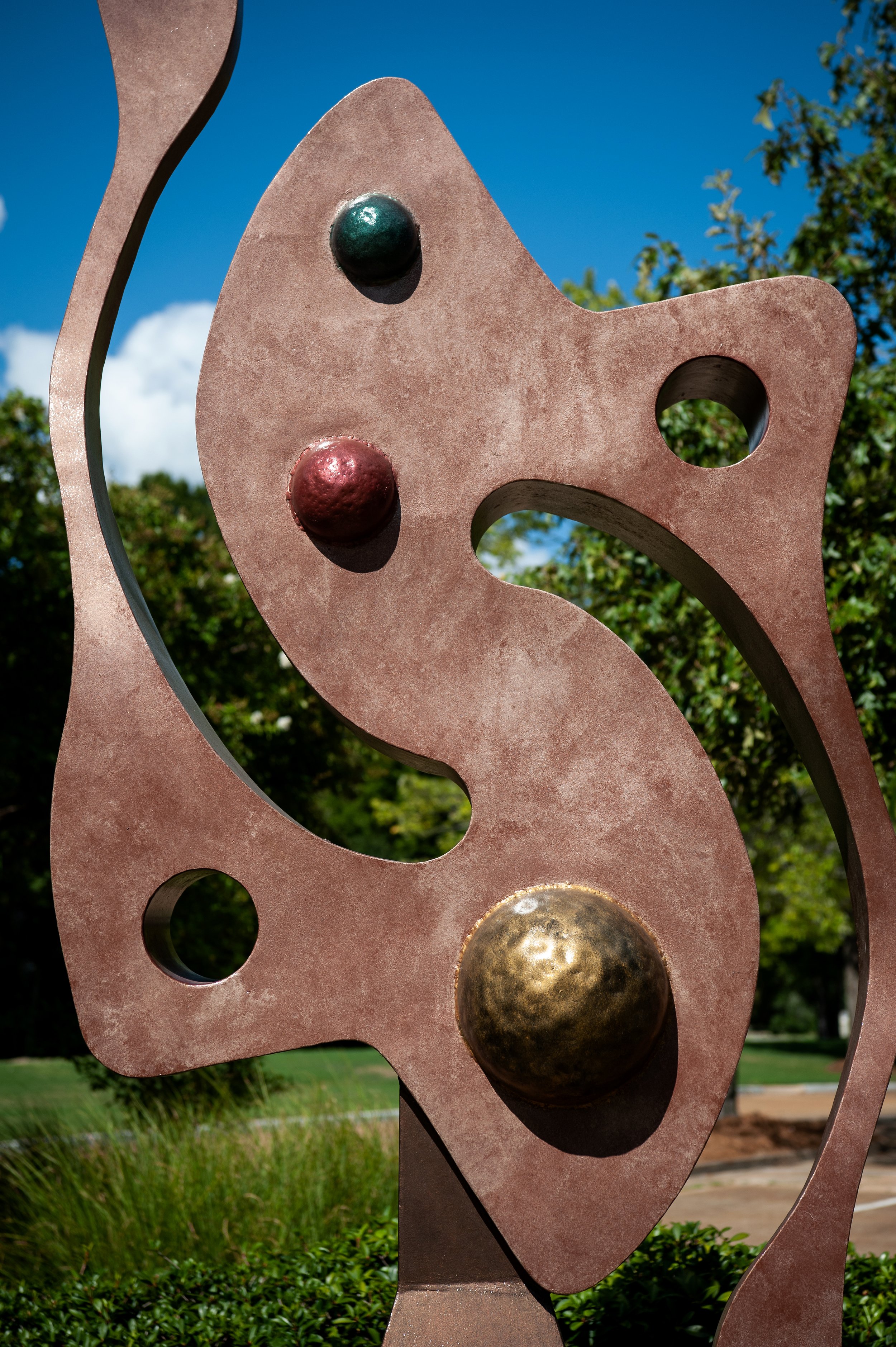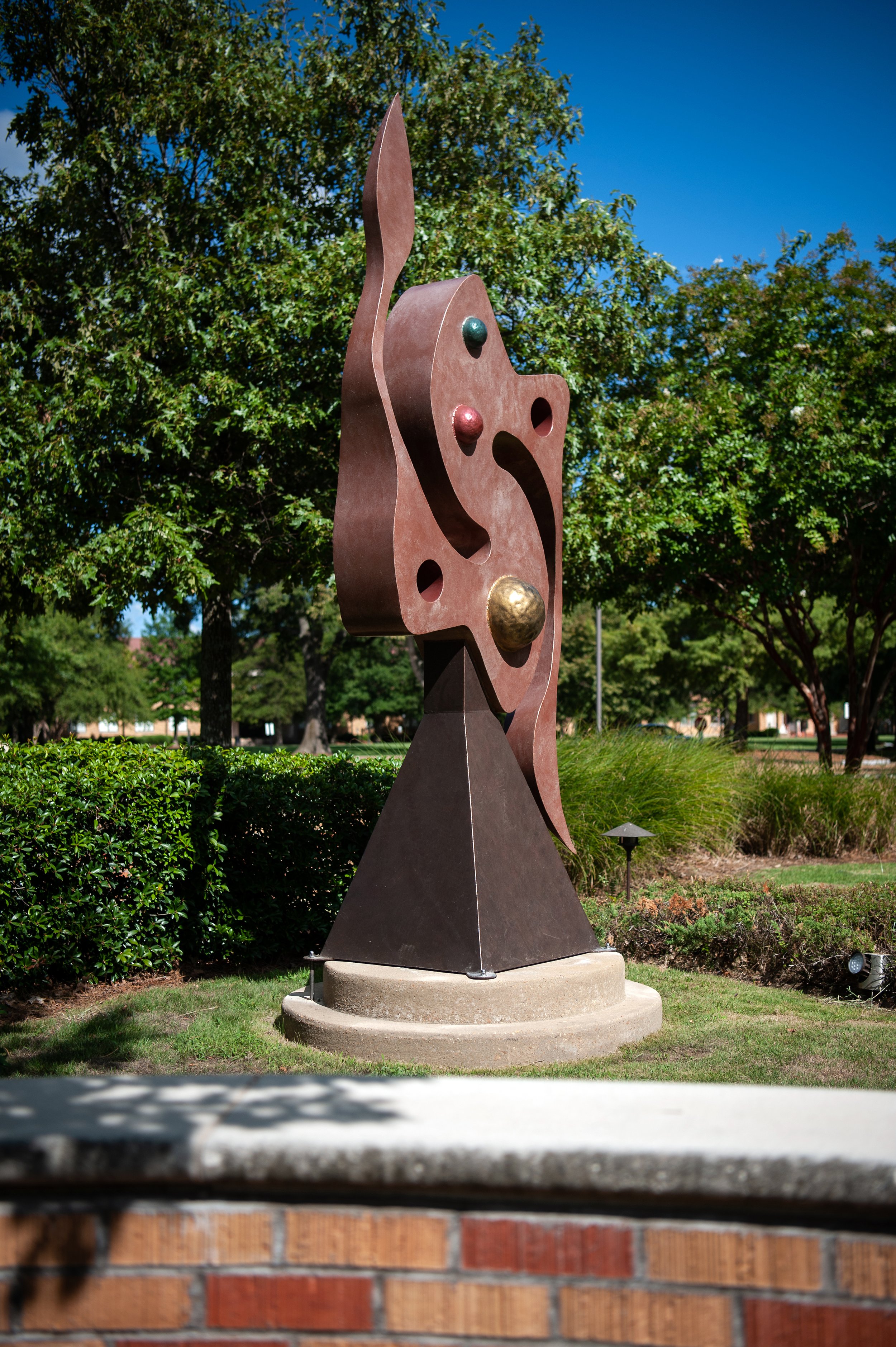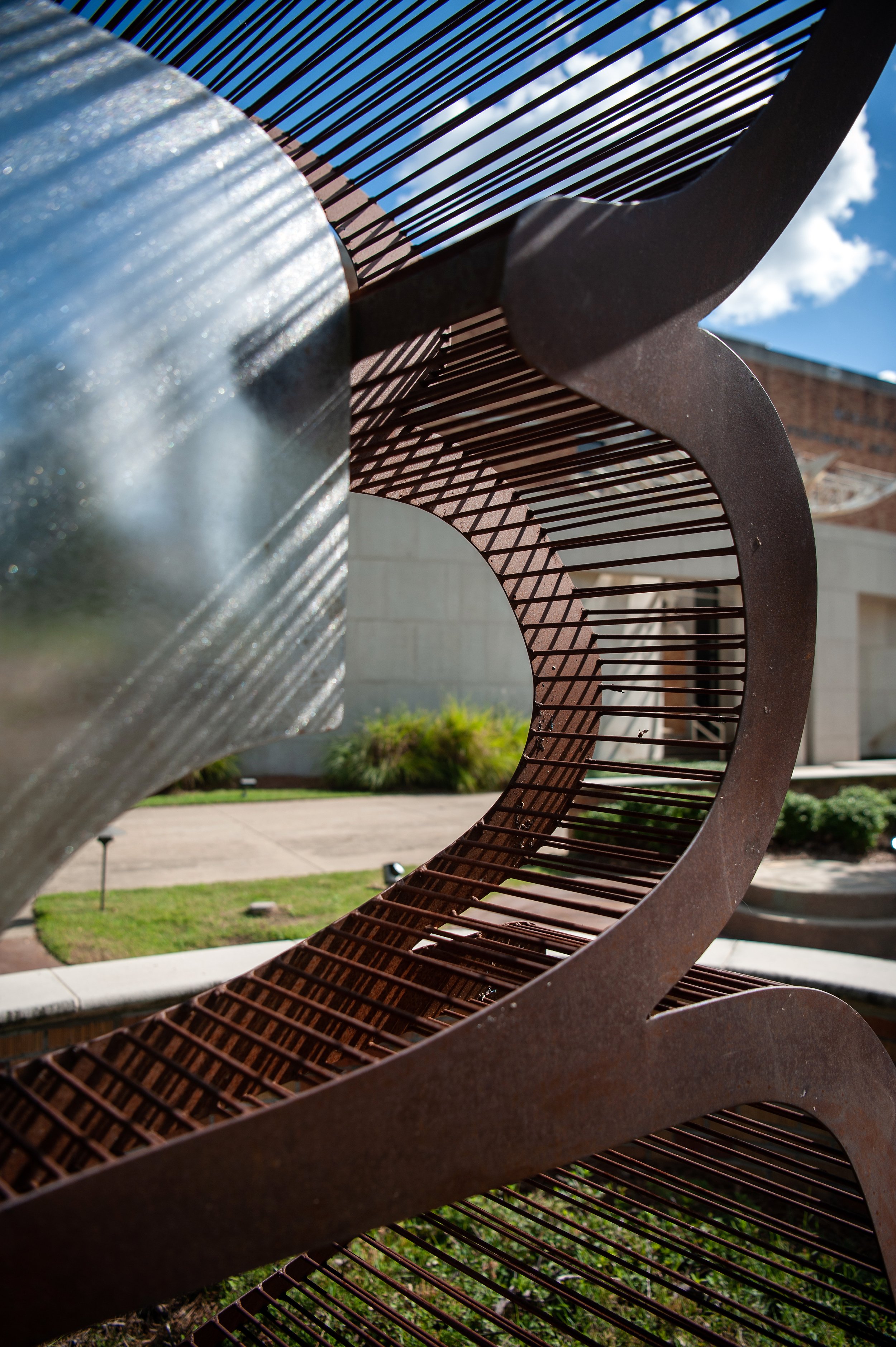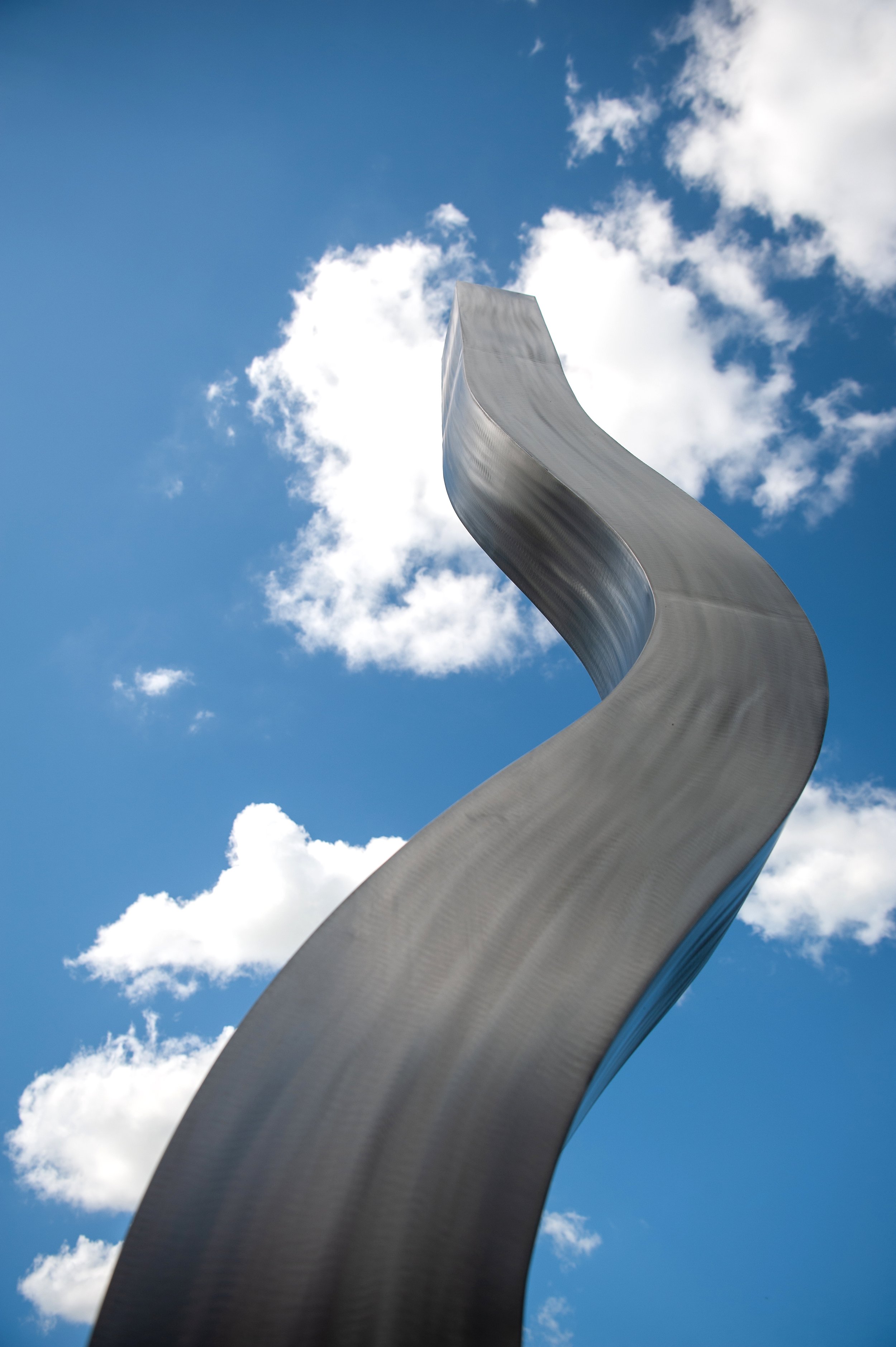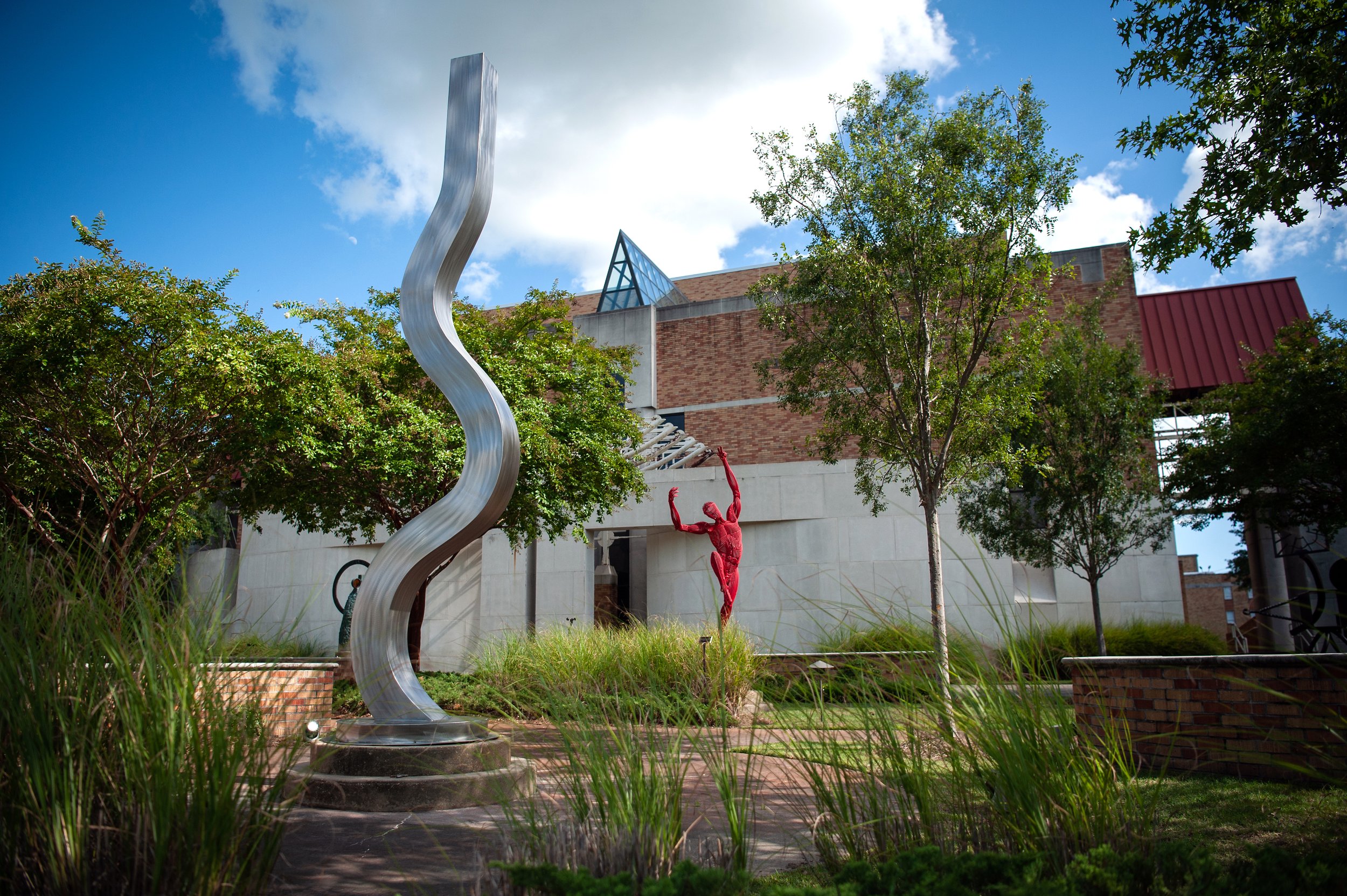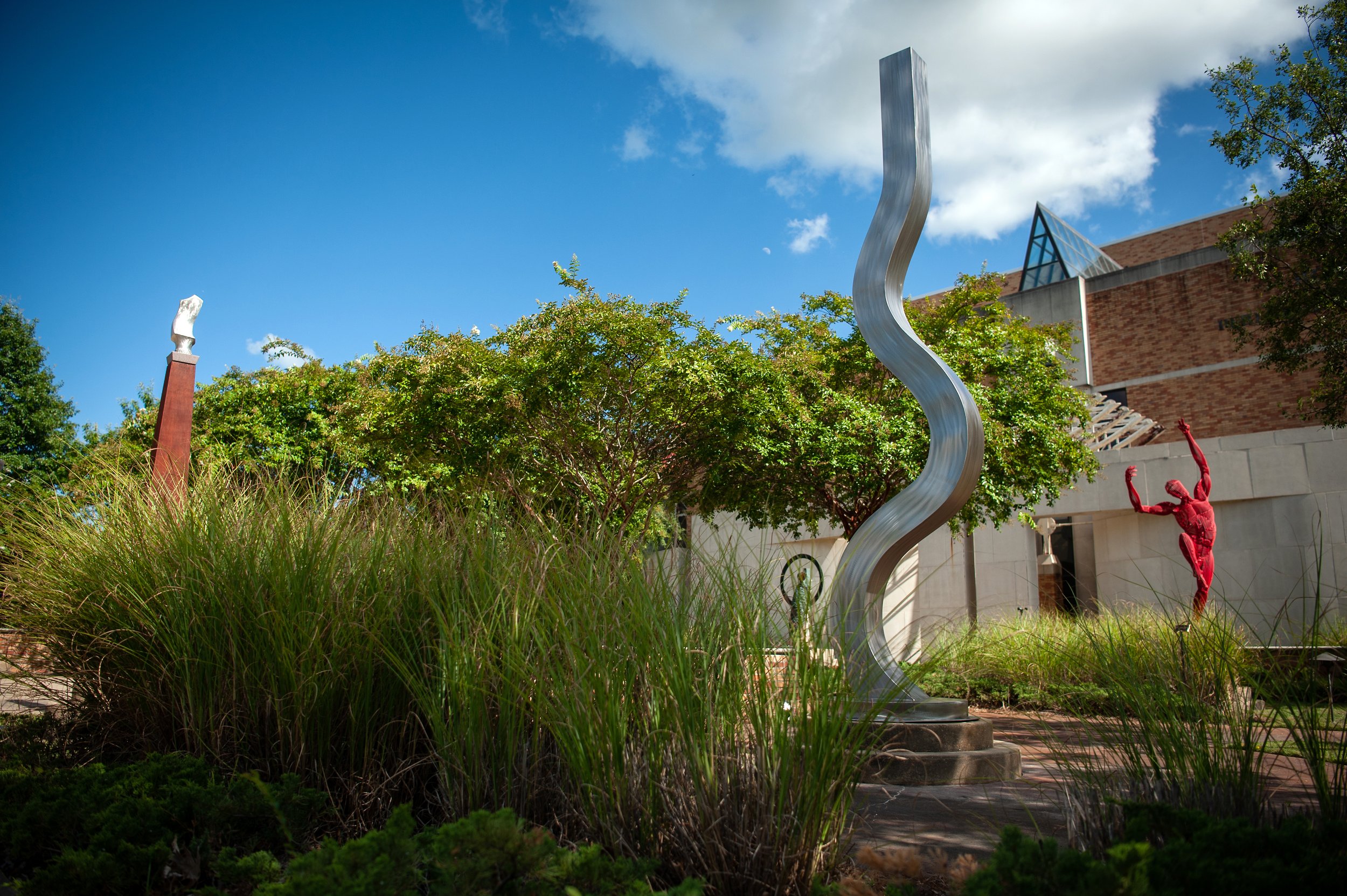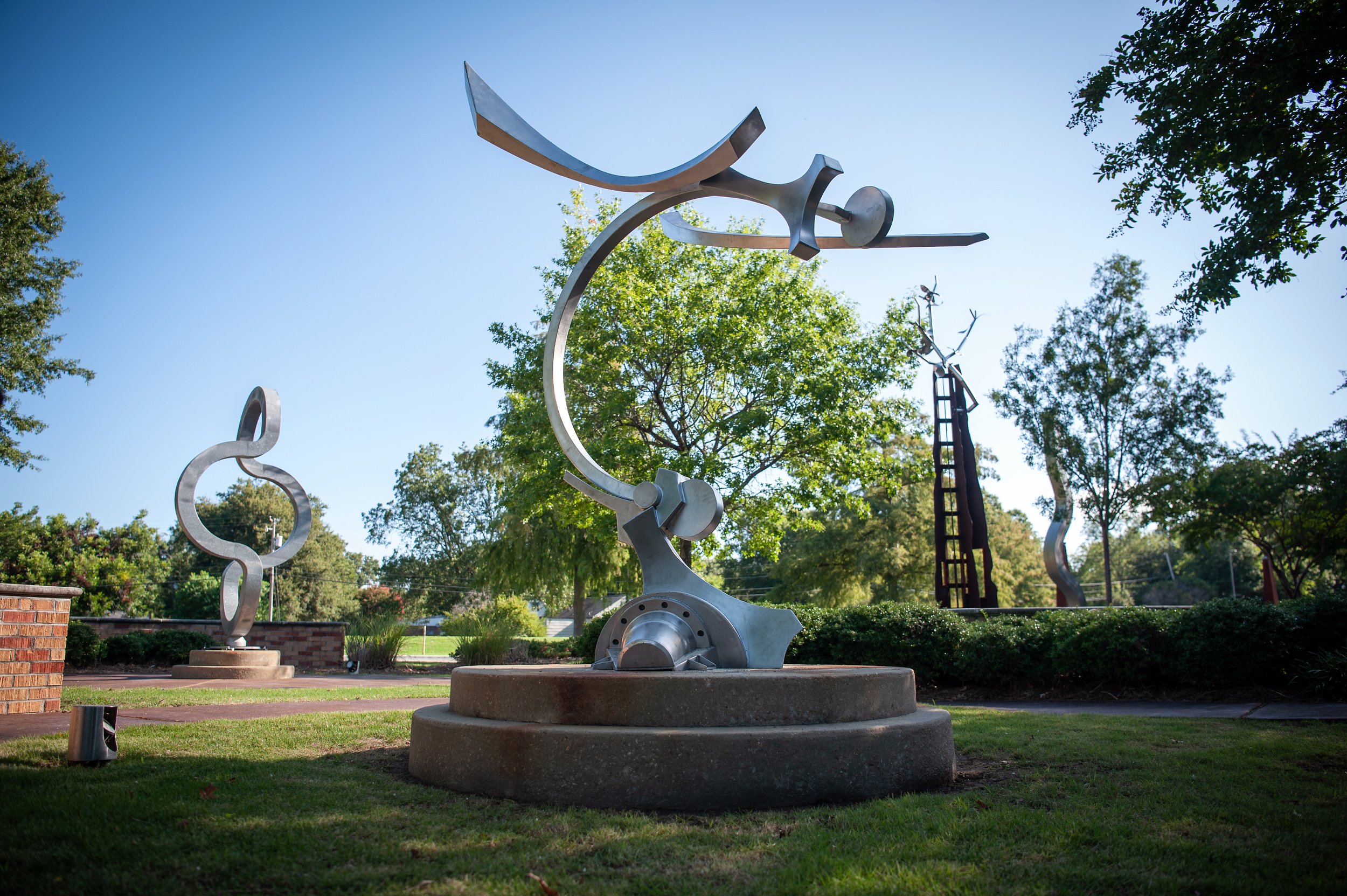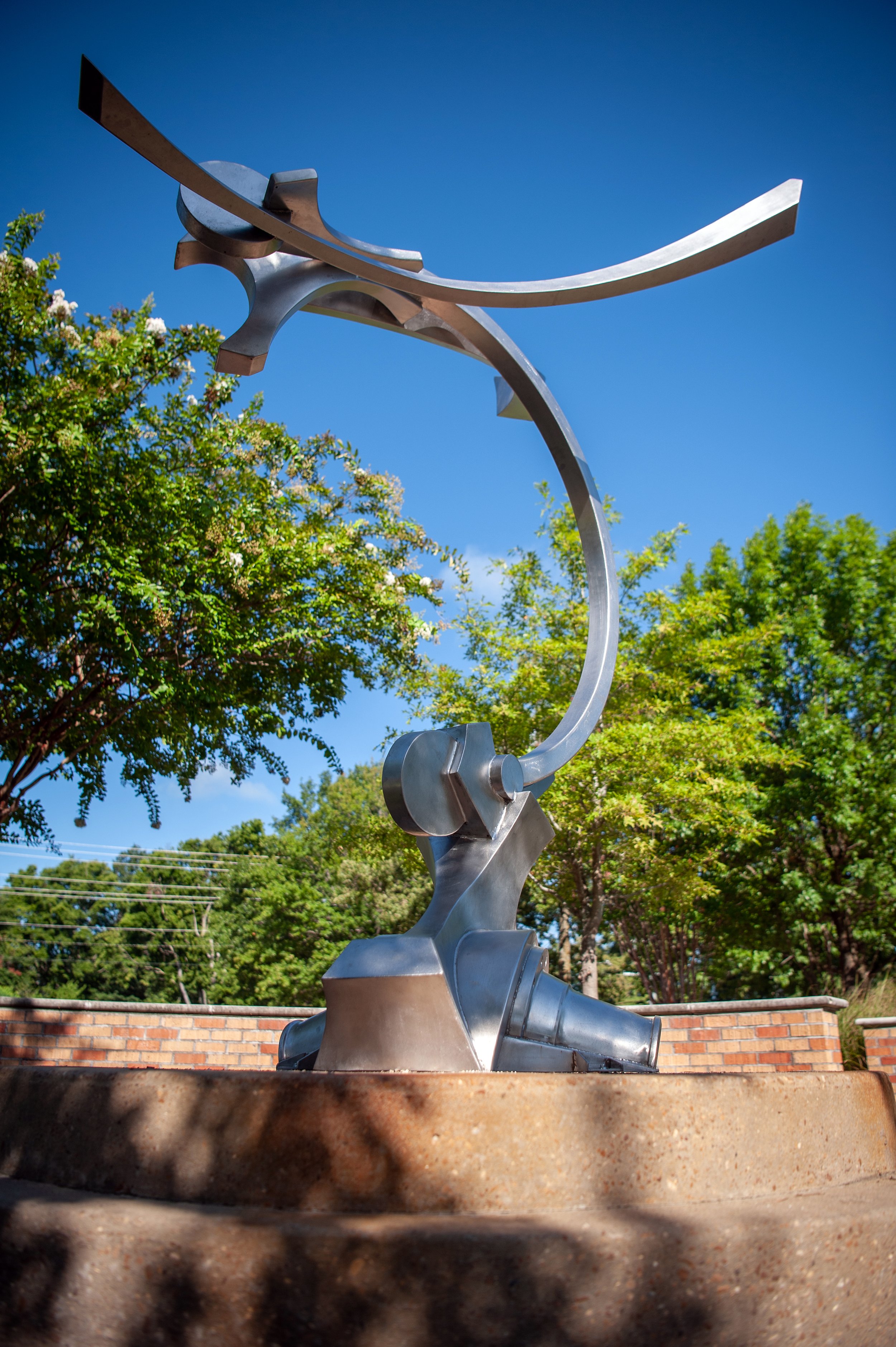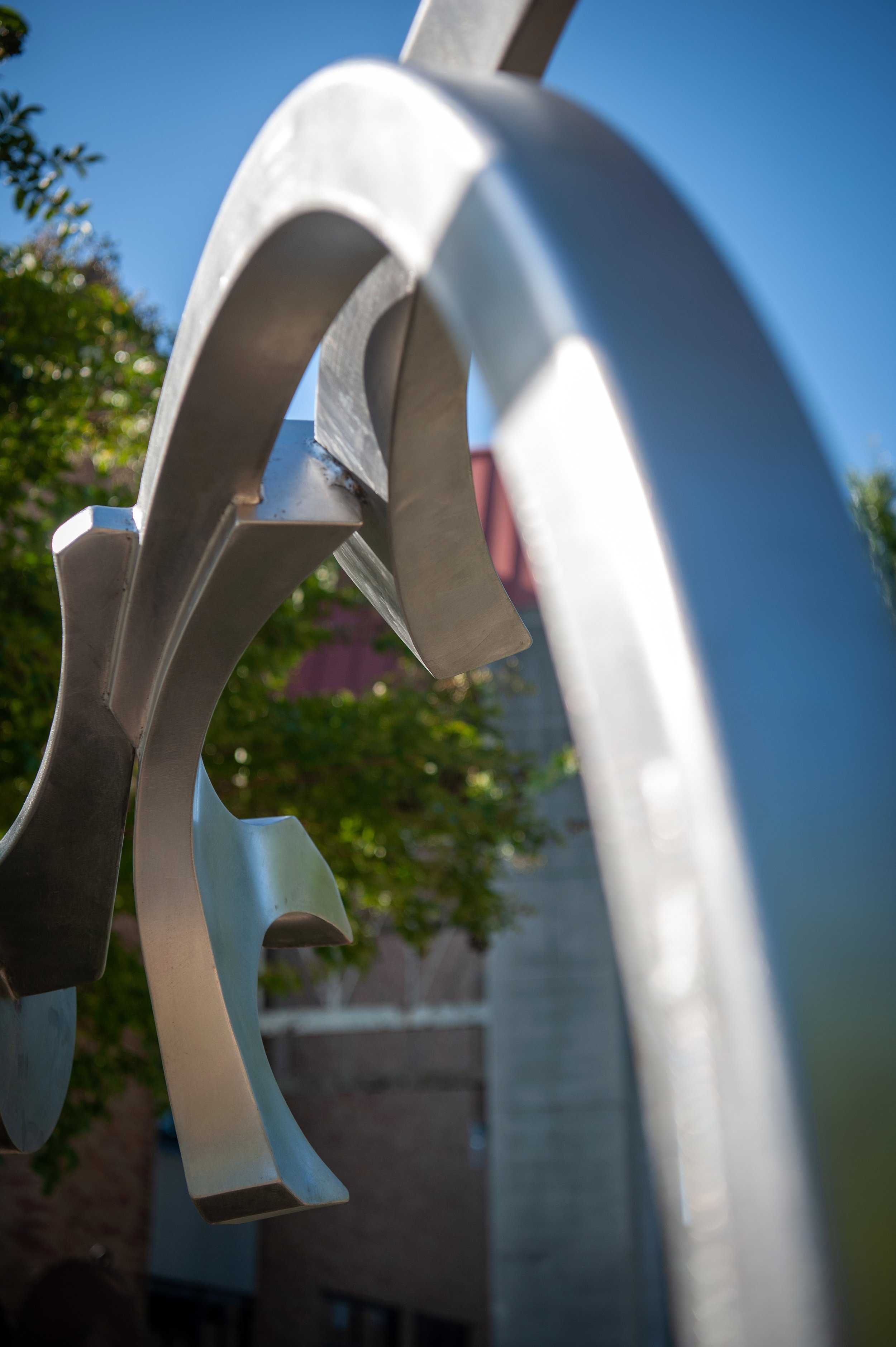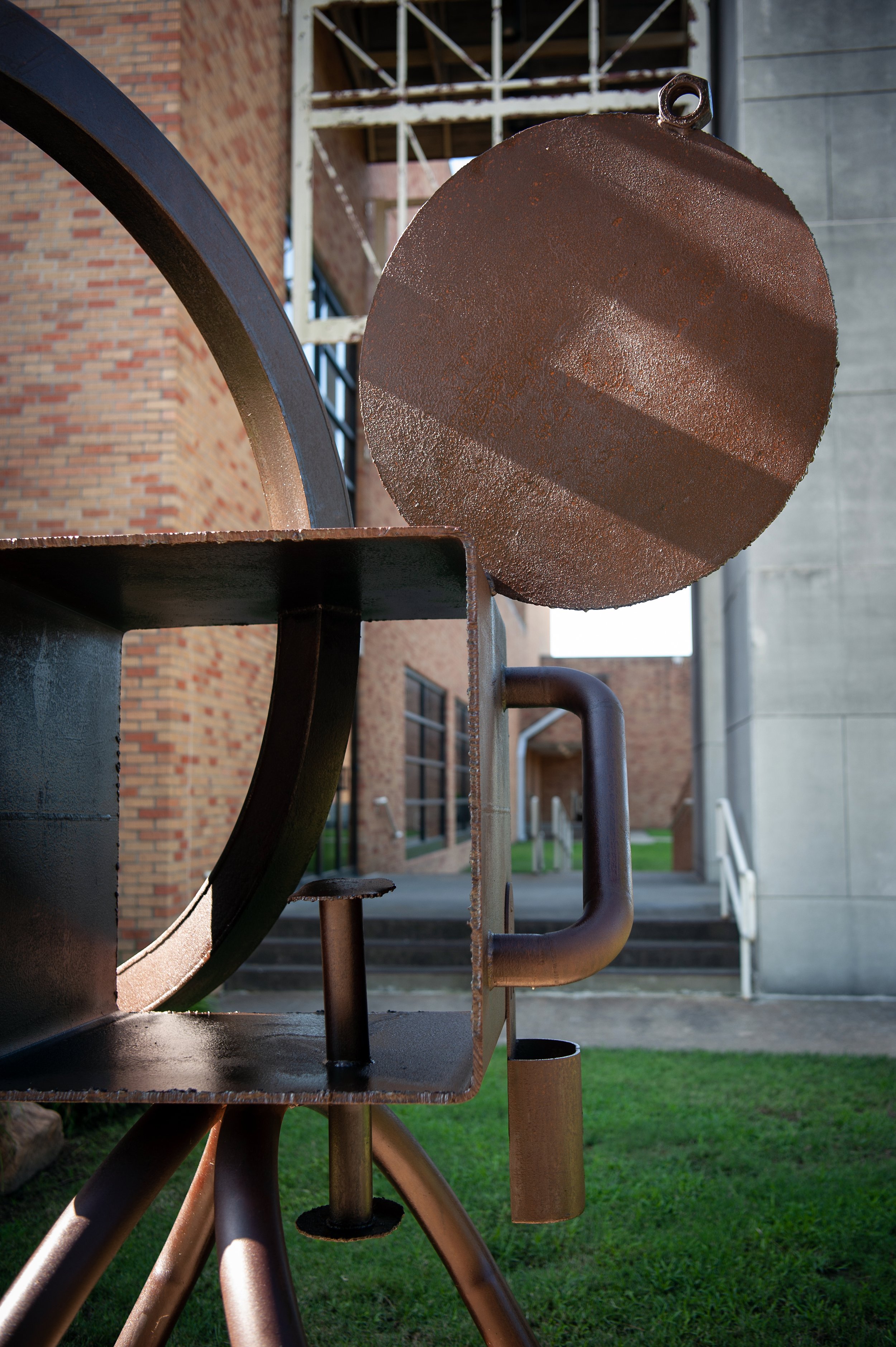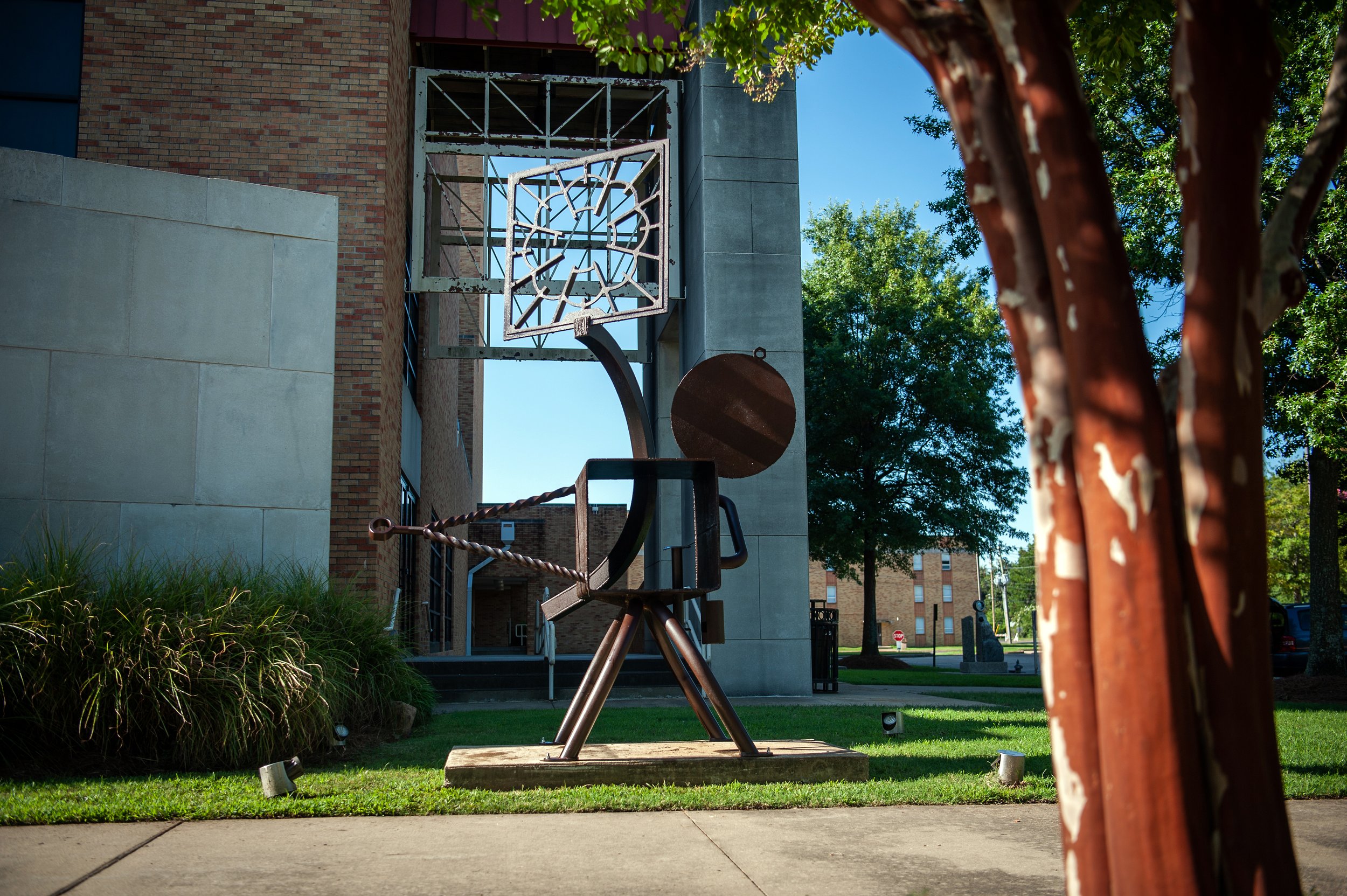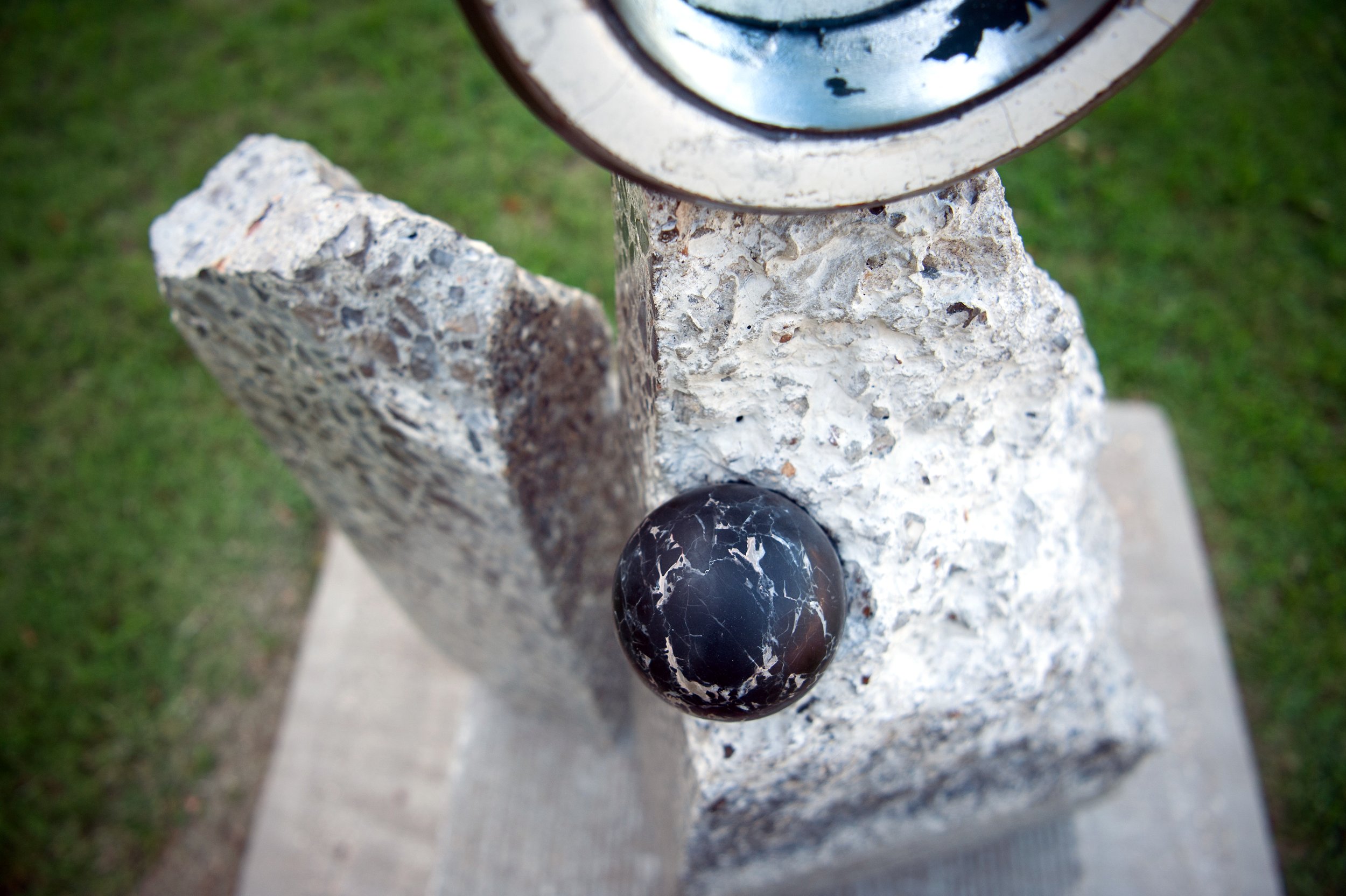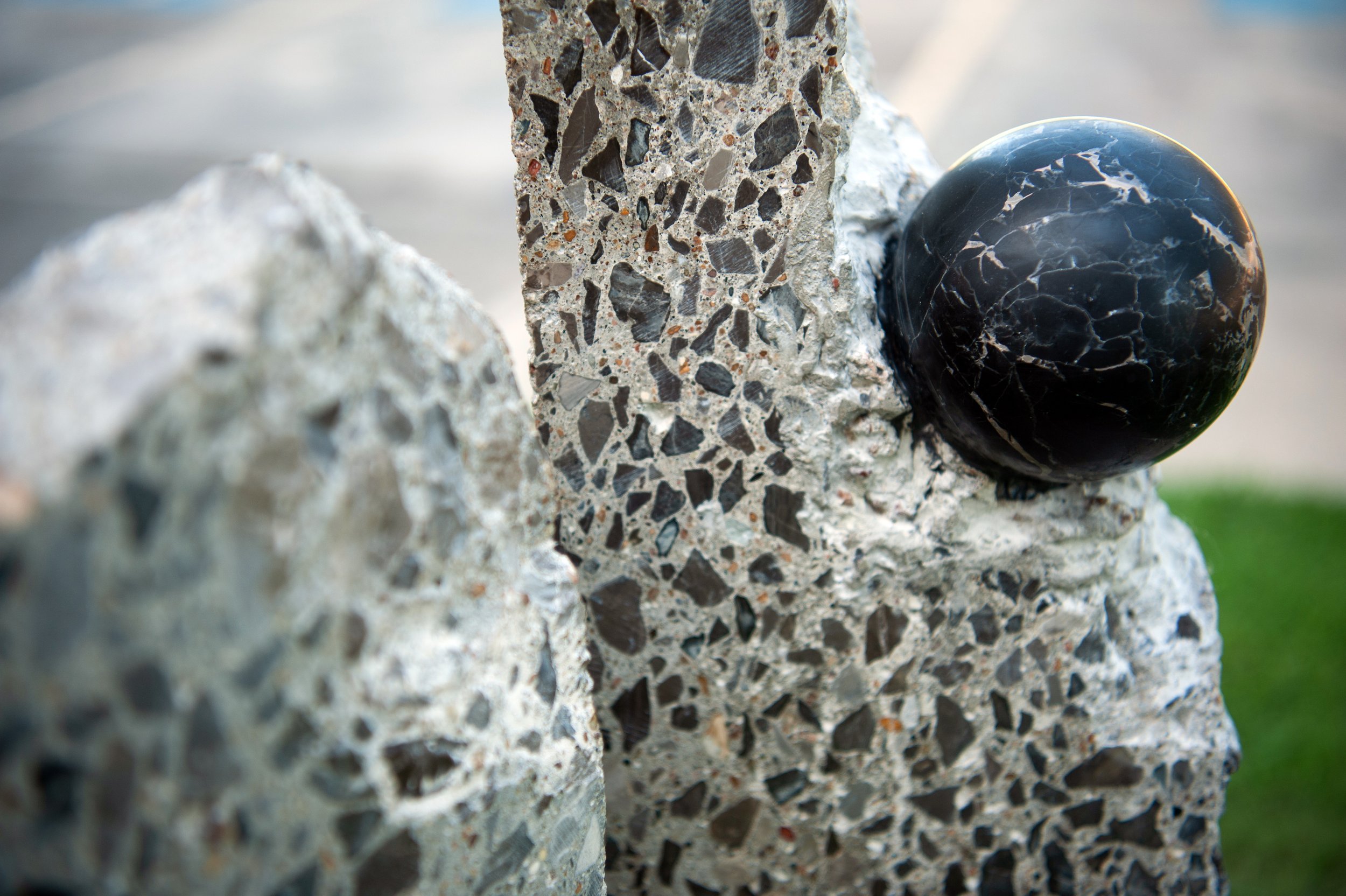Growing up in New Orleans with its rich and distinctive history and cultural atmosphere, and being raised by arts-centric, arts-valuing parents, Aaron Hussey was magnetically drawn to the arts and most specifically – public art, for as long as he can remember. “I have to be making. I have to be creating something. I have to make art, it’s the only thing I want to do,” he confesses. His recent creation, Magnolia Bluff, allows for Hussey’s return to the Mathews-Sanders Sculpture Garden and sees the Baton Rouge-based artist revisit a consistent theme throughout his entire artistic catalogue. “This was a key piece for me; it was a step-off to this whole series that marries this connection between the built environment with the natural environment,” he explains. “It’s meant to continue exploring the basic infiltration of this – the Earth, with our structural presences, as humans. What are our interactions destructing in nature?” Fabricated of corten steel, stainless steel and painted steel, this 2011 sculpture is constructed to have tree-like qualities and also possess windows near the bottom half of the physical structure. “Yeah, that’s another common idea in my pieces, for sure – this idea of a portal, or doorway. I think the hope there, is that someone will look at it with a different perspective. What does it mean to see something from the other side or what does it require to cross the threshold to other side? What can be gained from that? What awaits us there?”
Global Marker by Glenn Zweygardt
GLOBAL MARKER is a sculpture with a strong sinuous body of brilliant white marble on a base stone of the same material. A rectangular stone of metamorphic marble from Vermont rests on top. Curiously this densely green marble with white streaks, Verde Antique, was once a while marble also. Now it is as thick with green as an ancient forest. The top of the sculpture has two bronze elements. The lower one is a scribed globe; the upper is a thick crescent of bronze resembling the horns of an Egyptian deity. Looking at Global Marker, one has a sense of a long line of ancestors who shared an importance of belief and community with dignity and honor.
Stryker by Clifton Cox
I enjoy creating fabricated steel sculptures composed of intricately abstracted forms and structures, exhibiting measureless movement and energy. Inspired by organic and figurative elements, I like to combine them with mechanical components and balance them with volatile color and polished finishes. The goal is to create an interesting form with endless angles of composition, creating a mystical narrative, and captivating the viewers’ imagination beyond comprehendible measures. Stryker represents the inherent role of music and dance in the life of Native American’s ceremonial purposes of the “War Dance.” Fighting movements, and the use of weapons, are accompanied with indigenous music to prepare a warrior’s mental and spiritual amplitude for battle. Tomahawks, bows & arrows, lances, and knives were customary weapons used during a war dance, while drums, rattles, rasps, bells, and clap-sticks were habitually used instruments during war dance ceremonies. Stryker’s composition demonstrates the human figure, gesturing a tomahawk while engaged in an energetic dance of expression honoring the emotional and spiritual preparation of a hostile campaign.
Lovearch by Andy Denton
Lovearch is a cast aluminum figurative sculpture depicting a relationship. It depicts two figures forming a tenuous arch with their bodies, their feet at the apex and their hands the foundation. They support each other to create this impossibly strong feat. Without each other's support they would fall and dismantle the arch form. I wanted the figures to be epic, timeless and speak to all people. Instead of depicting clothing or skin, they have the texture of water. The water texture makes an aura that flows between the figures' feet and unites them. The sculpture seems to defy reality to tell a truth. There is no separation between nature and humanity. Humanity has a relationship with nature that is vital yet tenuous. About the Process: Lovearch took about 8 months to complete while a graduate student at East Carolina University. It was sculpted from home-made plasticine and modeled after real people, despite their distortion. Plaster piece molds were taken and wax copies were pulled from these. These wax pieces were packed in resin-bonded sand and then melted out and replaced with molten aluminum. The aluminum is 100% recycled metal, that were purchased from a scrap metal business. After it was cast in pieces, it was welded back together, the welds were sanded and hidden. The bases are welded steel and are meant to simply elevate the figures overhead.
Astral Projection/Tri Color by Ray Katz
Ray Katz is best known for his large-scale metal sculpture but works successfully in a wide range of media. Ray has exhibited sculpture publicly and privately throughout the Mid-West, Mid- South, West, and overseas in Paris, France and Tokyo, Japan.
Ray uses color because the properties of color are associated with social, political and spiritual beliefs inherent in the cosmology of all people. Color activates the elements and gives visual meaning to the organization of the abstract forms that he manipulates to create visual balance, using rhythm, action and movement. The implied energy of his compositional structures has become a hallmark of his work and is a metaphor for an evolutionary process that he associates with human experience.
Katz describes his compositions as abstract. The abstract manipulation of form in space to create visual balance, contributes to rhythm, action and movement. “My creative process requires organizing separate parts into a whole. I fabricate separate hollow forms and shapes and then intentionally combine them into compositions. I let the process of creation happen organically and quite spontaneously, instinctively and intuitively. The assemblage adds to the aura of complexity in the work. The activated forms are brought together to represent the flux of life and embrace transformative concepts such as evolution, metamorphosis and transcendence.”
Looper by Lawson King
Looper is a visual representation of the mental and physiological balancing act we all engage in the idea of “control.” When faced with the feeling of not having control, sometimes we grasp more tightly (to things, situations, people, etc.) to conserve feelings of convenience, safety, or comfort due fear of failure in the face of change. These behaviors can bring more adverse experiences, though, leading to mental or physical decline rather than growth. Letting go, on the other hand, can free us from the chains of the necessity to be in control. To know when it is best to hold on or let go is a challenge and sometimes we get turned around and around in the process. Bright colors relay an underlying but powerful positivity that dominates the darkness of being tangled up in such a situation.
Spiral Construction by Ray Katz
Ray Katz was born and raised in Detroit Michigan. He served on active duty in the United States Air Force for 4 years before attending College. He has a B.S. from Eastern Michigan University an M.F.A. from Wayne State University in Detroit, Michigan. Ray taught Sculpture, Drawing and Design at Oakland Community College in Auburn Hills MI for 48 years. During that time Ray maintained a welding and fabrication studio in Pontiac, MI on 5 acres of reclaimed industrial land and buildings. Ray is best known for his large-scale metal sculpture but works successfully in a wide range of media. Ray has exhibited sculpture publicly and privately throughout the Mid-West, Mid- South, West, and overseas in Paris, France and Tokyo, Japan.
Ray uses color because the properties of color are associated with social, political and spiritual beliefs inherent in the cosmology of all people. Color activates the elements and gives visual meaning to the organization of the abstract forms that he manipulates to create visual balance, using rhythm, action and movement. The implied energy of his compositional structures has become a hallmark of his work and is a metaphor for an evolutionary process that he associates with human experience. Through the creative process a hierarchy of elements, become symbols for ideas, that are a tribute to the transcendental experience we all share in common, and in the transcendent experiences inherent in life’s journey.
Katz describes his compositions as abstract. The abstract manipulation of form in space to create visual balance, contributes to rhythm, action and movement. “My creative process requires organizing separate parts into a whole. I fabricate separate hollow forms and shapes and then intentionally combine them into compositions. I let the process of creation happen organically and quite spontaneously, instinctively and intuitively. The assemblage adds to the aura of complexity in the work. The activated forms are brought together to represent the flux of life and embrace transformative concepts such as evolution, metamorphosis and transcendence.”
Rectangular Abstract by Robert Porreca
This sculpture is a totally abstract composition. Being so there isn't much I can say, especially since interpretation is in the eye of the beholder, which is the point of the whole thing. With a successful abstraction, the design will be interesting enough to hold the attention of the viewer, giving pause to interpretation and some enjoyment in the visual experience.
My studio is cluttered with objects and shapes that intrigue me. It was from a collection of things that were box-like and rectangular I began designing. It's how I work generally There isn't much of a preconceived concept, just the shapes and object on the workbench. The process that takes place is my reason for working with abstraction. It is the purest form of artistic expression I know and I enjoy it immensely. I used the model created from the rectangular scraps to help guide me to this greatly enlarged version in epoxy.
Social Fabric by Matt Miller
Matt began his education with the intent to become an architect but soon realized he loved the building process even more than the design. He said, “I had worked in construction for many years, you think I would have realized this a little sooner.” He changed his major to art education with a minor in architectural design and found his direction in life.
Teaching now for many years, Matt enjoys the constant connection with art. He can be found in his classroom teaching art as well as creating. “I think for me to be a successful art teacher, I must first be an artist.” He continues to educate beyond the walls of his room, in other classes and the community.
"Social Fabric" is an example of how he uses art to analyze himself and his relationships with the world around him. "It seems like we all think we know what makes us "tick". But if we set back and listen, we begin to realize that the daily clicks of our rhythmic relationships are who we really are in this life."
Miro’s Garden by Wayne Vaughn
Nature and industry inspire my work. I strive to bring animation, balance, and intrigue to my creations, playing on gravity, but keeping trust between the piece and its landscape. My hope is that my work invites the viewer to play, question, and respond.
Joan Miro’s painting ‘The Tilled Field’ depicting a stylized view of his family farm in Catalonia is an inspired setting for ‘Miro’s Garden.’ Can’t you just see it rising above a bed of flowers amongst all the surrounding iconography? I enjoyed the challenge of bringing focus, color and playfulness to this large-scale image and hope it brings a smile, invites a conversation, or inspires an artist’s creation.
Surround by Hanna Seggerman
Hanna Seggerman is a multidisciplinary artist and educator who creates two- and three-dimensional works that are shown nationally in both gallery and public art exhibitions. She is currently attending graduate school to receive her Master of Fine Arts degree in sculpture from the University of Tennessee, Knoxville. Seggerman will complete her thesis exhibition in May of 2023. Alongside her studio work and teaching, she serves as the Director of Gallery 1010, the student-run non-profit gallery in downtown Knoxville that hosts weekly exhibitions of student artwork, performances, and curatorial projects. Her recent studio work has a foundational relationship with the structure of Maslow’s Extended Hierarchy of Needs. She continues to find the act of artmaking to be a means to meet both personal and universal needs. Her work titled “Surround” on exhibit here in the Mathews-Sanders Sculpture Garden is an exploration of deconstruction. She uses this as a means to achieve abstraction, forcing the viewer to slow down. “Surround” was intimately inspired by the performative act of dissecting in half a twin sized mattress, exposing the many resilient materials within. Most notable were the metal bed springs that were referenced in the construction and form of “Surround.” This act of deconstruction brought forth the hidden details of this common human object we utilize on a daily basis and share the same living space with in connection with our own human bodies. Seggerman works to create opportunities like this for light to be shed on the objects that are often disregarded due to their visual separation from the outside world.
Reach! by Ben Pierce
Ben Pierce is a veteran and Missouri native who found an outlet for his internal struggle by creating sculpture. He says: “I have been living with depression for many years (way before I began making art). Only recently have I begun to speak openly about it with friends and family. A lot of mental illness is suffered in silence- I am choosing to use my art as a way to help others speak up. Maybe someone will hear about this or read this and feel HOPE. You are not alone! Or through my openness about depression it will allow others to not suffer alone by giving them courage to seek help or confide in someone. Maybe this can open that conversation for them. My art/sculptures possibly would not have been created if it weren't for my need to externalize what I go through inside. I hope you find your own voice and can endure any obstacle that comes your way.”
“Reach! is made from stainless steel and stands 15.5 feet tall. Curving from its base then transitioning to a straight right-angled form at the top. Organic, yet human-made. Designed intentionally minimal in its form, allowing the viewer to wonder “what is it?” hopefully exploring their own creative mind for the answer. Is it a growing plant? Is it a winding flowing river? I leave the viewer to decide what they see.”
Anomie Exquisite by Andrew Light
Most of my work is derived from a merger of my aesthetic impulses and their translation through direct metal working techniques. This piece began as a response to a find in the scrap pile. Frequently I’ll come across a given form, a pre-manufactured widget of some sort, find it interesting, and off we go. Once that gets cleaned up, I’ll assess its potentials as an art object, then begin working with it. Slicing in, capping off, adding to and peeling back as needed. After a period of time, it’s “done,” and that’s the end of it. The title of this piece is derived from something I was reading at the time, which featured a discussion on the topic of Durkheim’s “Anomie,” being defined as: a social condition in which there is a disintegration or disappearance of the norms and values that were previously common. As I tend to repurpose materials, depriving them of their intended use, notions of “Anomie” began to feel quite appropriate. In building the piece of satin finished stainless steel, it occurred to me that “Anomie” could in fact be in beauty, and it was a swift path to the title form there.
Dingbat by Earl Dismuke
My sculptures are abstract, made from wood, steel, cast aluminum and found objects. Some of these found objects you see in your everyday life, but others are rather bulky industrial metal castoffs that he finds while searching scrap yards and fabrication plants. My work tells my story, but I like to leave enough ambiguity in the work that the audience can make their own interpretations. Dingbat is the second piece in a series of works based on the fantasy of my childhood imagination. Dingbat is an ode to story telling and the outlandish stories I heard as a child. The word dingbat itself is defined as a noun meaning a stupid or an eccentric person. However, I always viewed it as a term of endearment. As a child, when I was trying to be funny or entertaining, telling my own outlandish stories, my mother would call me “dingbat.” In the South story telling is still very much a part of our culture.
Remembering Pam at #10 by Ron Koehler
Ron Koehler is a sculptor with extensive exploration in all types of media such as stone, steel, bronze and his preferred media of wood. As a result, he continually sees art in the objects and places that others might overlook. Such is the circumstance that led to his entry into this year’s competition. “When I first saw this triangular piece of concrete, I was totally inspired. I immediately knew what the finished piece would look like and drew a sketch of this sculpture.” The “where” of this inspiration came along an interstate highway in a pile of rubble that caught his attention, and the “why” was as a tribute to the late Pam Mathews for whom this biennial competition is named. The idea and format of this competition was the brainchild of Pam and her good friend Nan Sanders. She is the one who brought all of us together, and all of the sculpture to Delta State and the community. This piece symbolizes the triangular relationship of me, the Sculpture Garden, and the sculptors that I have gotten to know during the past 22 years of my association on the sculpture garden committee. Included at the top is apiece of cast glass given to me by Glenn Zweygardt who has participated in 8 of the previous competitions.”


